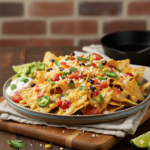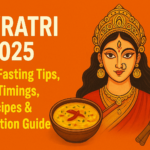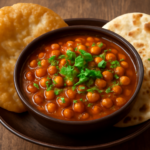Navratri 2025 Dates, Fasting Tips, Puja Timings, Recipes & Celebration Guide.
- by harmanblogs1@gmail.com
- September 15, 2025
- 0
- 14 Min Read
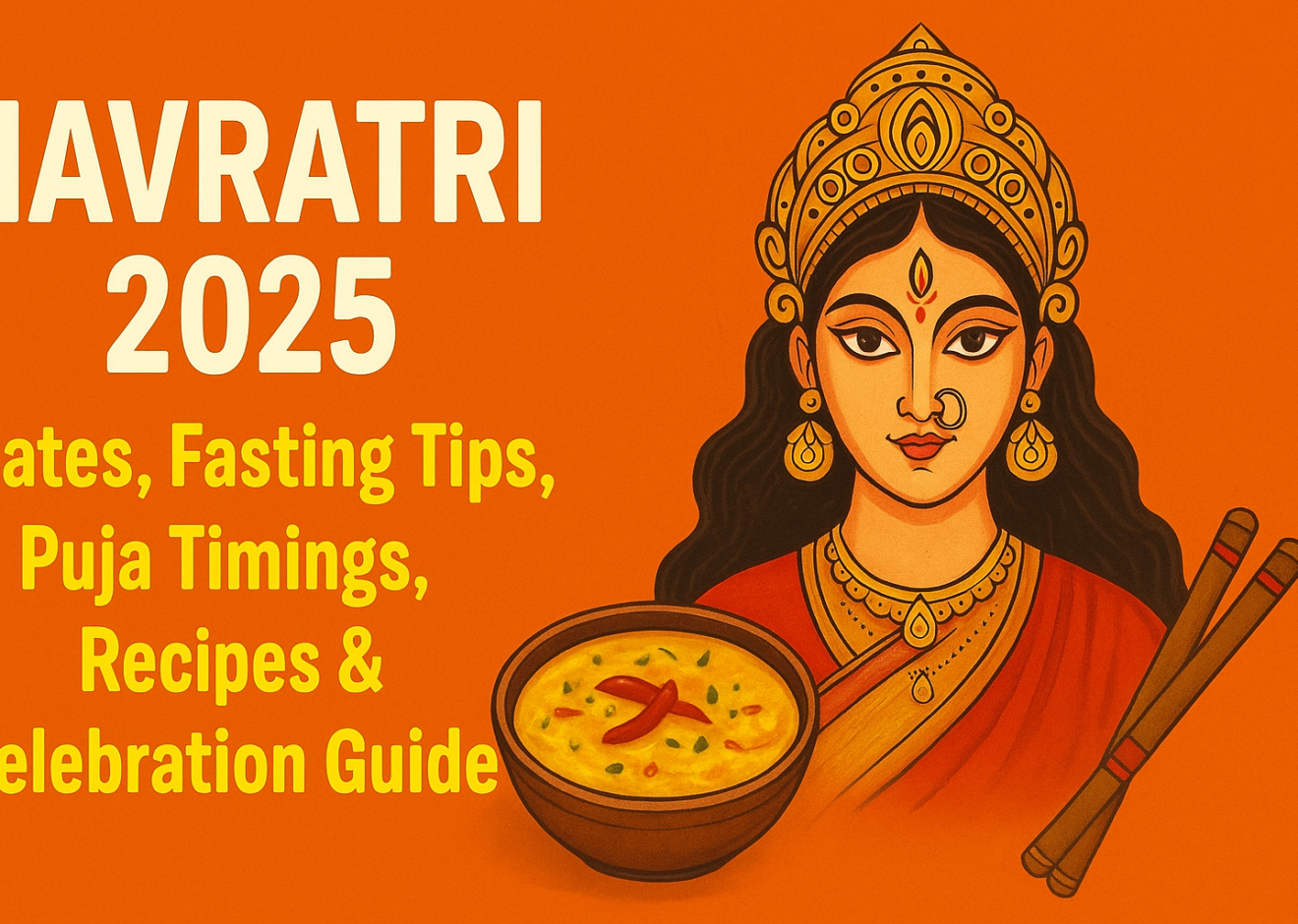
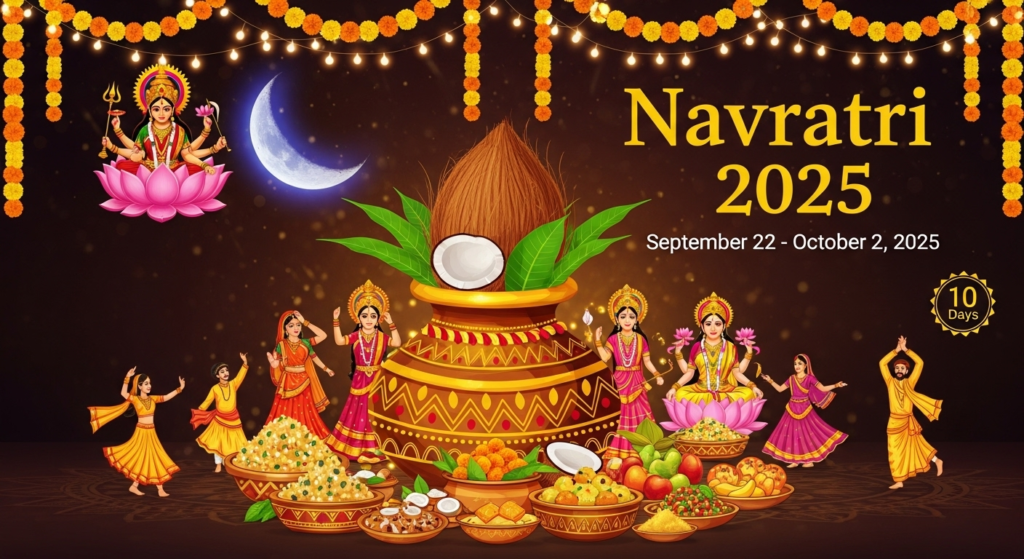
Table of Contents
ToggleAbout Navratri- Spiritual Essence:
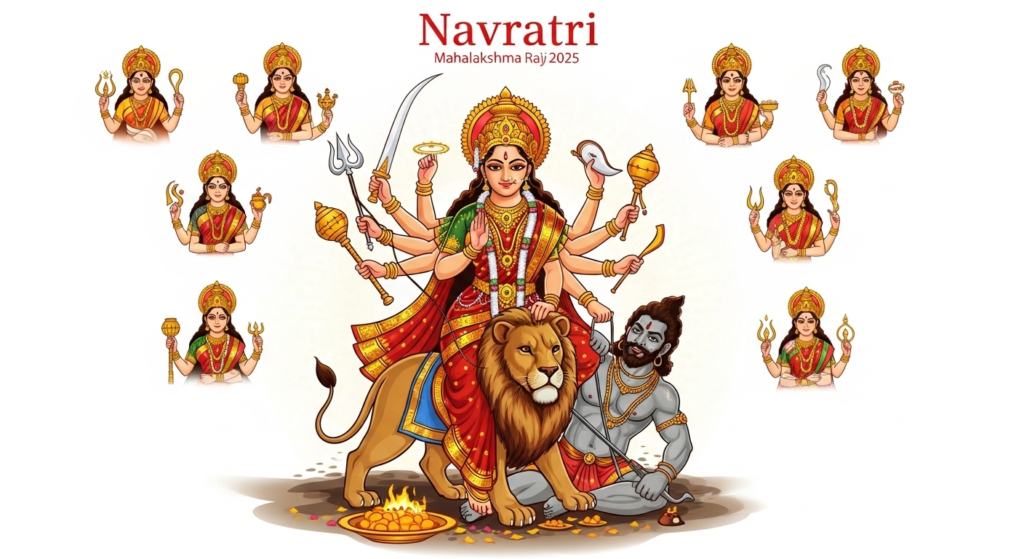
Navratri — meaning “nine nights” — is dedicated to the nine forms of Goddess Durga, each representing a distinct virtue such as courage, wisdom, compassion, and protection. It commemorates the victory of Goddess Durga over the demon Mahishasura, symbolising the eternal triumph of good over evil.In 2025, the festival also coincides with an auspicious Mahalakshmi Rajyoga on 24 September, believed by astrologers to bring prosperity and success.
Dates & Duration
- Start Date: Monday, 22 September 2025 (Ghatasthapana / Kalash Sthapana)
- End Date: Thursday, 2 October 2025 (Vijayadashami / Dussehra)
Special Note: This year, the festival spans 10 days instead of the usual 9, as the lunar calendar alignment places Vijayadashami right after Maha Navami without a gap.
Meaning of “Lunar”
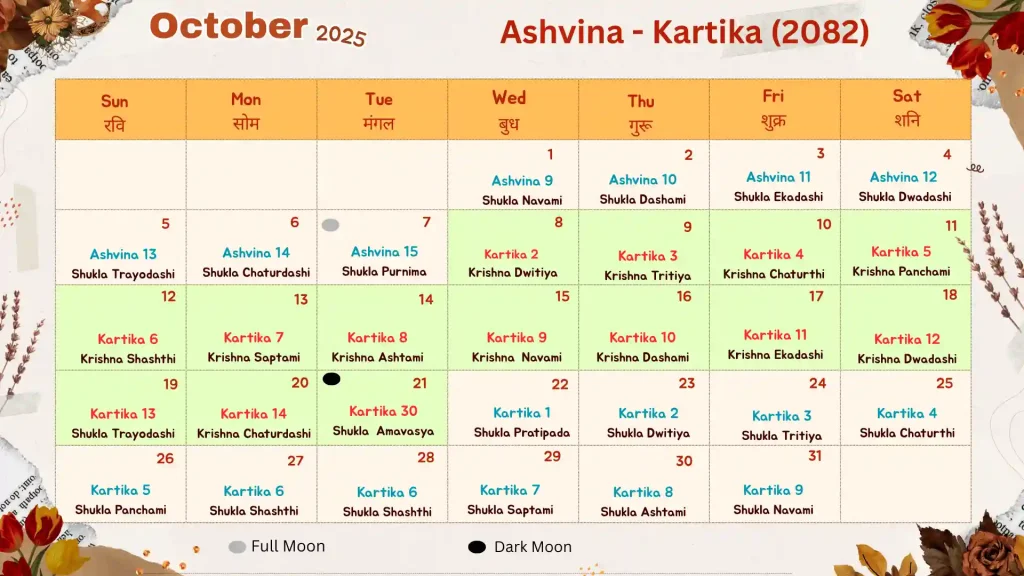
The word lunar simply means “related to the Moon.” In the context of Navratri, it refers to the lunar calendar — the traditional Hindu calendar that follows the Moon’s phases rather than the solar year. Navratri is counted from the day after the new moon day, marking the first nine days of the lunar cycle, which are considered especially auspicious for worshipping the feminine divine.
Ritual Highlights of Navratri
1. Ghatasthapana (Kalash Sthapana) – 22 September
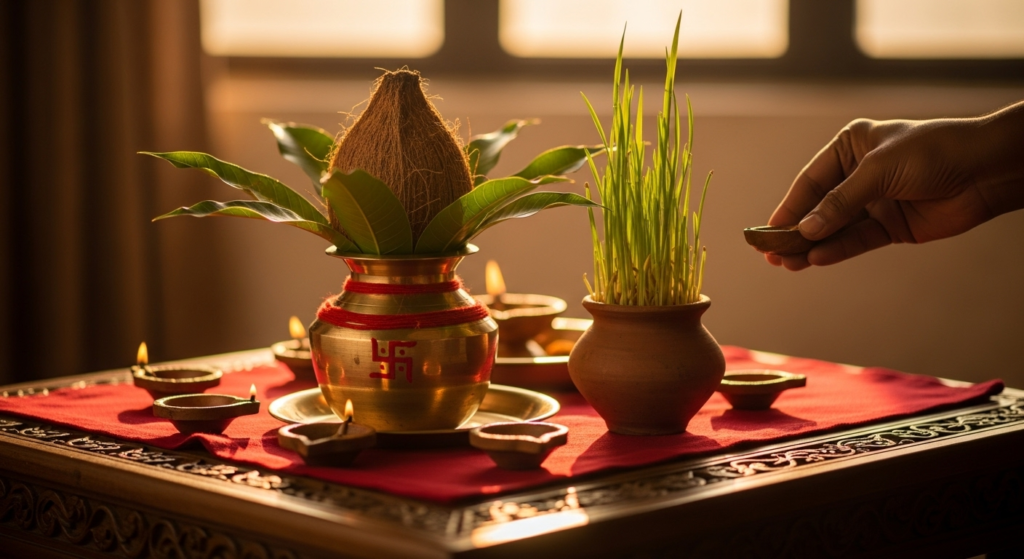
- Performed during the auspicious morning window 6:08 AM – 8:06 AM.
- A sacred pot (Kalash) is placed with mango leaves, coconut, and barley seeds, symbolising life, fertility, and abundance.
2. Cultural Celebrations
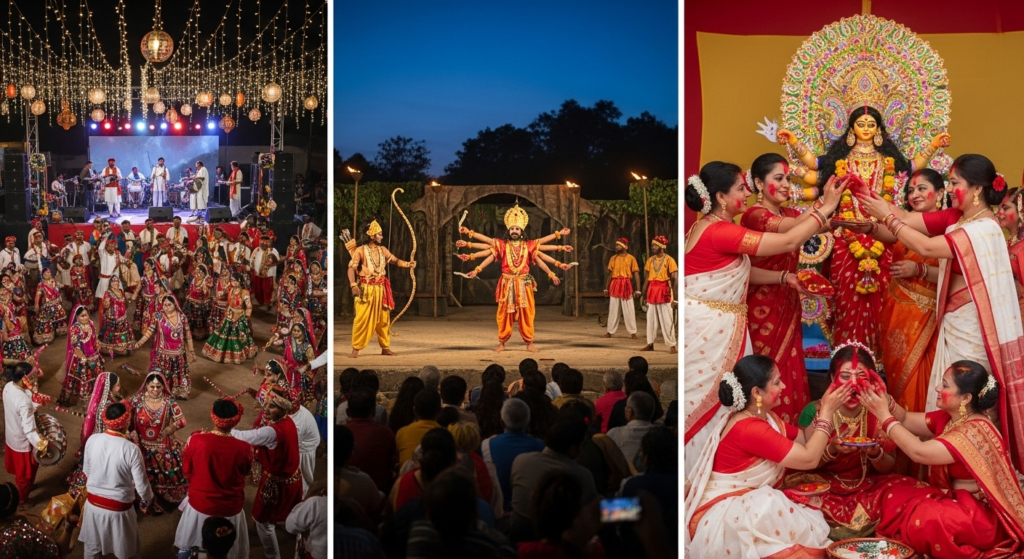
- Garba & Dandiya Nights in Gujarat and across India, with vibrant music and dance.
- Ramlila Performances in North India, narrating the Ramayana.
- Sindoor Khela in Bengal on the final day, where married women apply vermilion to each other as a blessing for prosperity.
Daily Goddess Worship
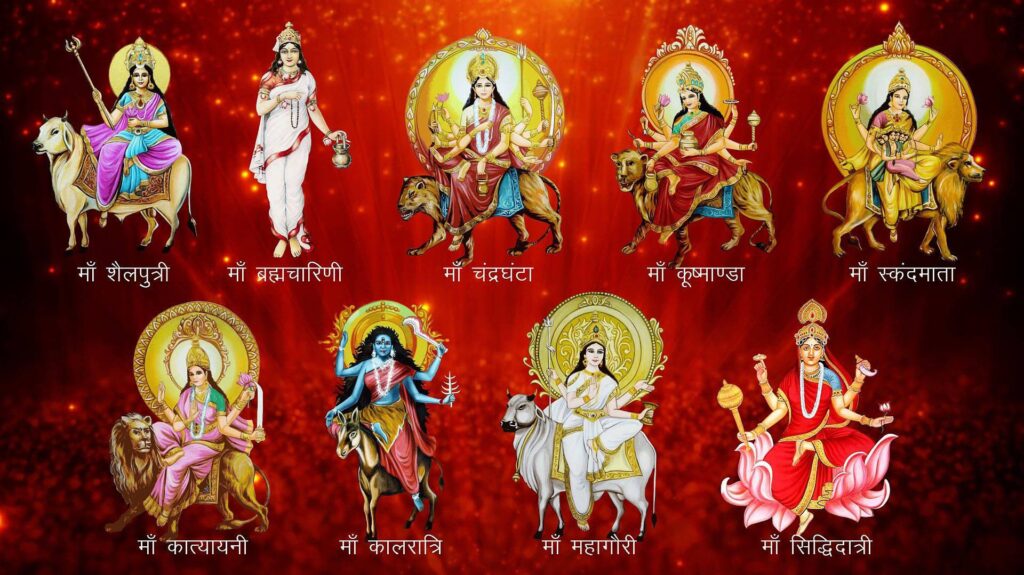
Each day honours a different form of Durga, with a symbolic colour and offering:
Day 1 – Sept 22 Shailputri White Purity & new beginnings.
Day 2 – Sept 23 Brahmacharini Red Devotion & energy.
Day 3 – Sept 24 Chandraghanta Royal Blue Courage & calmness.
Day 4 – Sept 25 Kushmanda Yellow Joy & vitality.
Day 5 – Sept 26 Skandamata Green Growth & compassion.
Day 6 – Sept 27 Katyayani Grey Strength & discipline.
Day 7 – Sept 28 Kalaratri Orange Protection & fearlessness.
Day 8 – Sept 29 Mahagauri Peacock Green Peace & harmony.
Day 9 – Sept 30 Siddhidatri Pink Fulfilment & blessings.
Day 10 – Oct 1 Maha Navami — Culmination of worship.
Day 11 – Oct 2 Vijayadashami — Victory of good over evil.
Navratri Festival in India – How Different States Celebrate
Navratri is one of India’s most colourful and joyful festivals. It’s celebrated in many different ways across the country, but the spirit is the same everywhere — devotion, music, dance, and togetherness. Here’s how it’s enjoyed from East to West and North to South:
West Bengal, Odisha & Assam
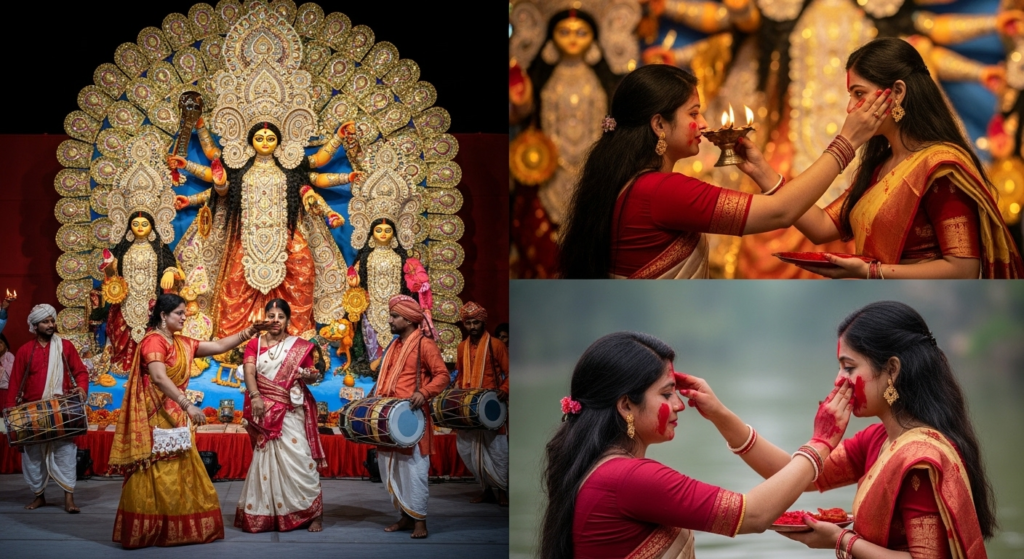
Here, Navratri is celebrated as Durga Puja, honouring Goddess Durga’s victory over the demon Mahishasura. The celebrations start on the sixth day and continue for the last four days of Navratri. People visit beautifully decorated pandals, watch the traditional dhunuchi dance to the beats of the dhakis (drummers), and enjoy delicious bhog (sacred food). On the final day, married women take part in Sindoor Khela, applying vermilion to each other before the idols are immersed in water.
Maharashtra
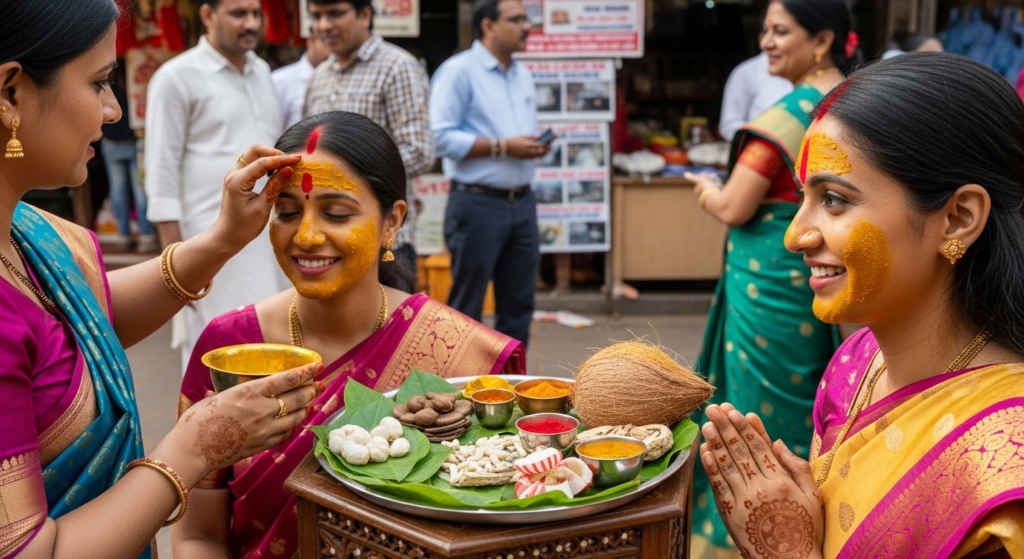
For Maharashtrians, Navratri is a time for new beginnings. Many people buy property or start new business deals during this period. Women celebrate Saumangalyam by applying turmeric and vermilion to each other’s foreheads and exchanging betel leaves, betel nuts, and coconuts as a sign of goodwill.
Gujarat
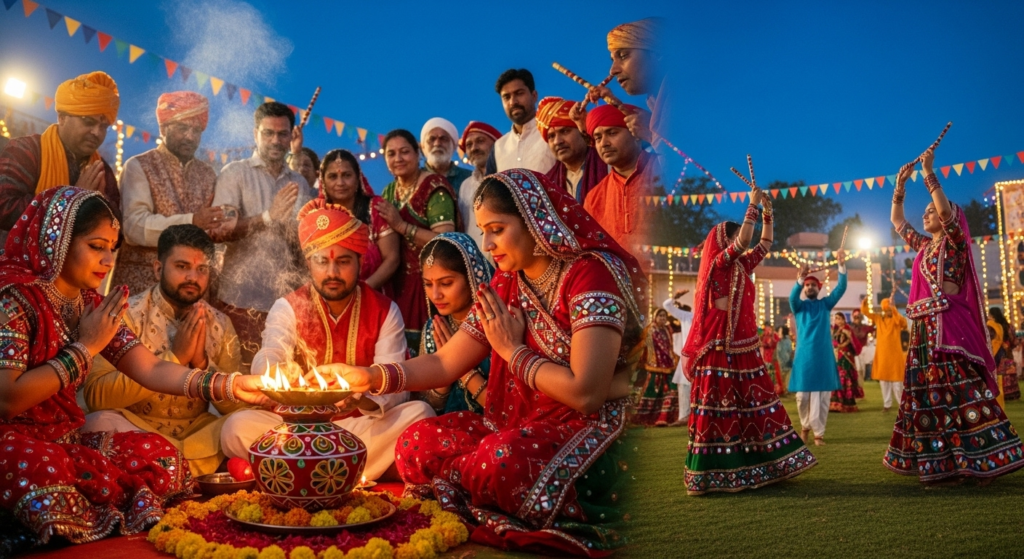
In Gujarat, people worship Maa Ambe and often fast for nine days. Evenings begin with an aarti around a garbi (an earthen pot with lamps symbolising life), followed by the lively dances of Garba and Dandiya Raas, where men and women dress in colourful clothes and dance late into the night.
Punjab, Uttar Pradesh & Bihar
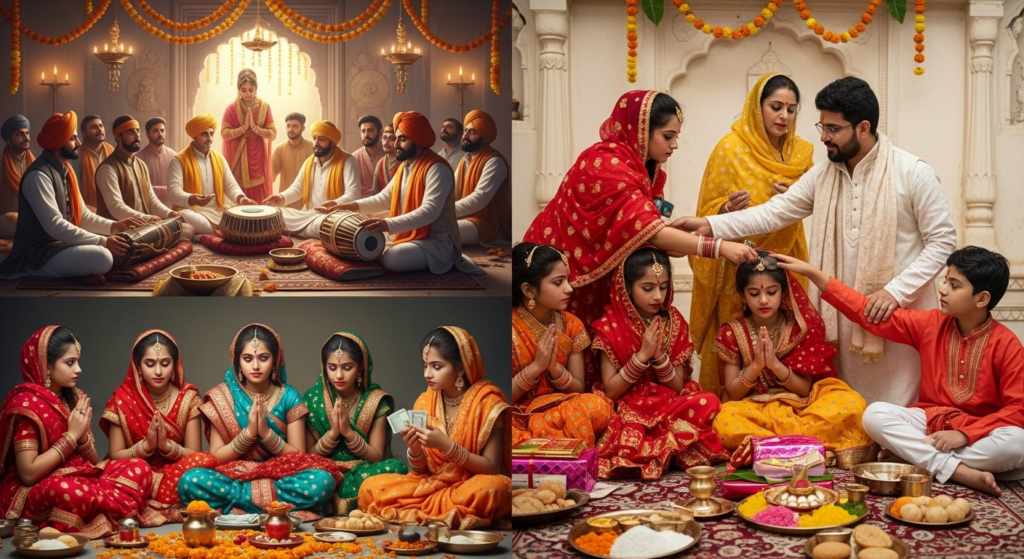
Here, many people fast for the first seven days and spend the nights singing devotional songs in jagrans. On the eighth or ninth day, they perform Kanjika Puja, where nine young girls (representing the nine forms of Durga) and one boy (symbolising Lord Bhairav) are worshipped. They are given gifts, money, and a special meal of halwa, chana, and puri.
Himachal Pradesh
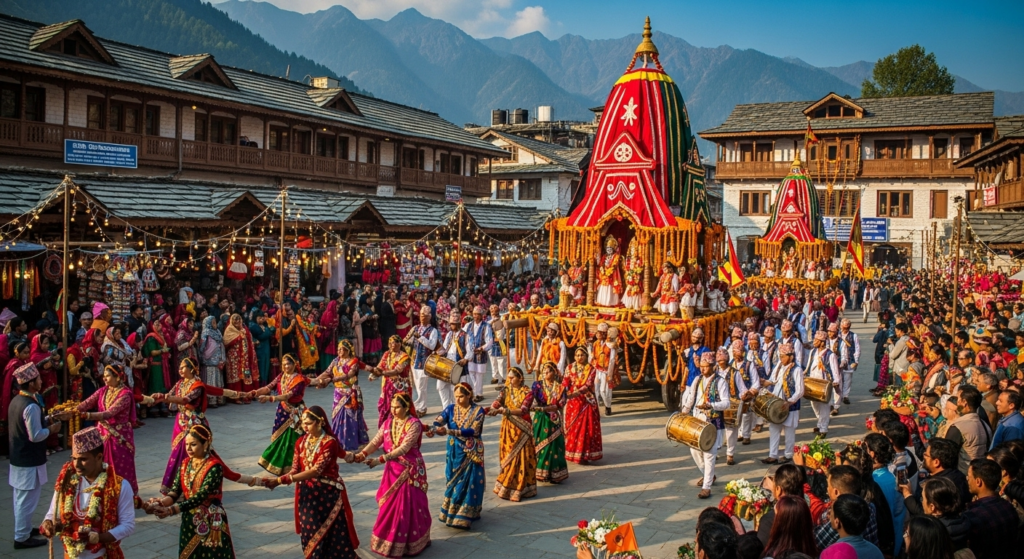
In Himachal, the celebrations actually start on the tenth day with Kullu Dussehra, while they end in most other states. This day marks Lord Rama’s return to Ayodhya. The festivities include the traditional Nati dance, music, feasts, and colourful processions.
Karnataka
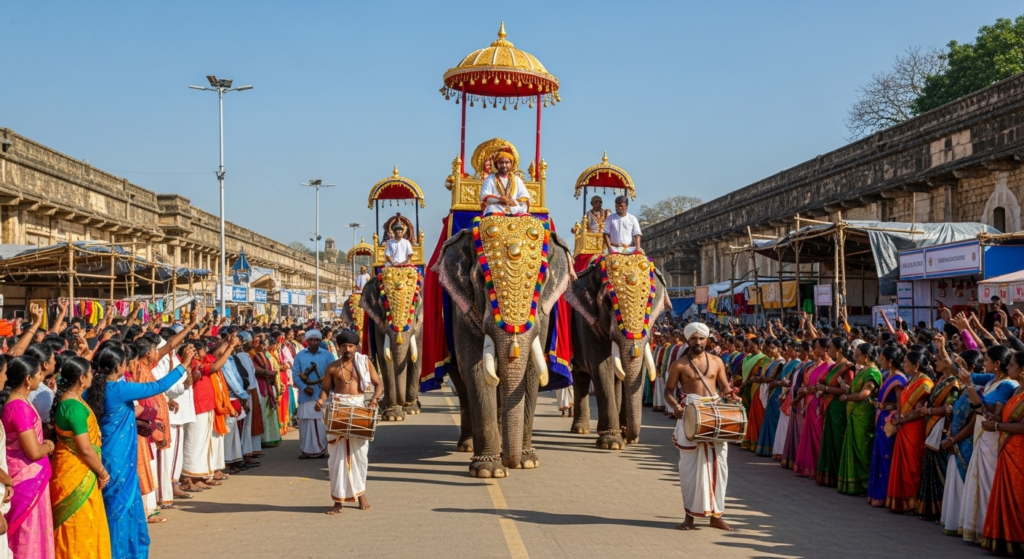
Known as Nadahabba (state festival), Navratri in Karnataka is celebrated in the same grand way it was during the Vijayanagara dynasty in the 1600s. The final day features a royal procession of decorated elephants, along with fairs, exhibitions, and cultural shows across the state.
Tamil Nadu
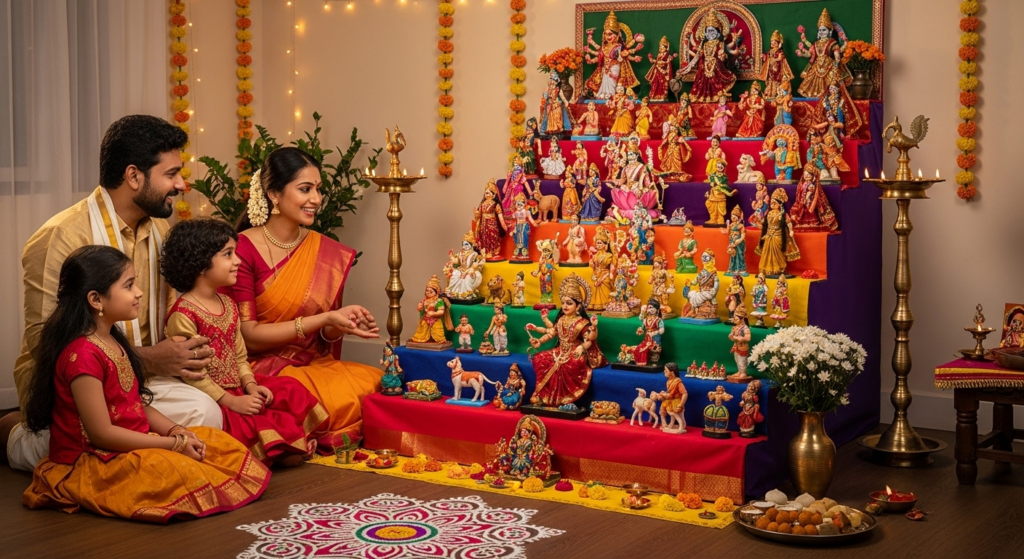
In Tamil Nadu, the nine days are dedicated to Goddess Durga, Goddess Saraswati, and Goddess Lakshmi. Families set up Bommai Golu — a nine-step display of dolls and idols passed down through generations. Evenings are for visiting friends and family, exchanging gifts, and enjoying festive treats.
Andhra Pradesh
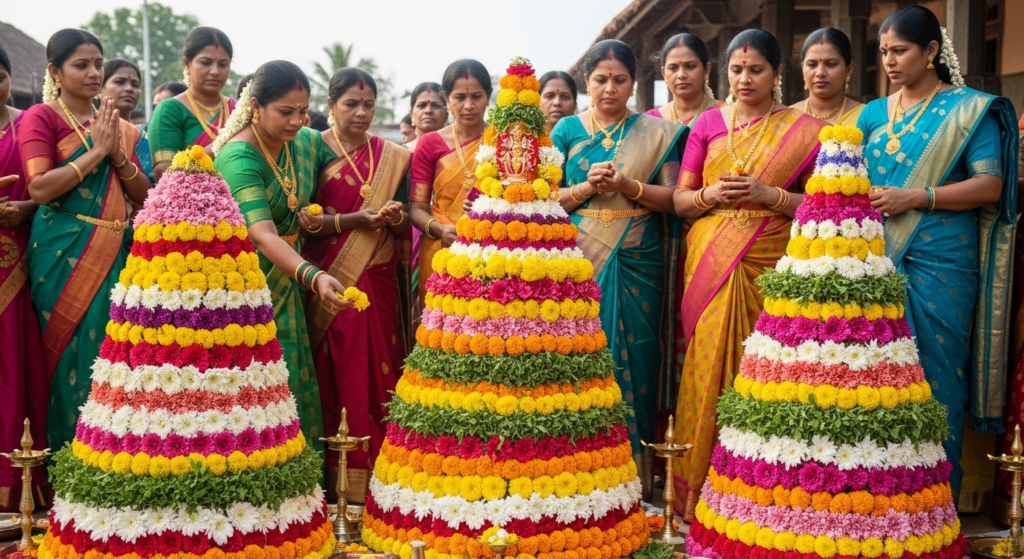
Here, Navratri is celebrated as Bathukamma Panduga, dedicated to Maa Gauri, the goddess of womanhood. Women wear new sarees and jewellery, make beautiful stacks of seasonal flowers, and perform rituals before immersing the floral arrangements in water on the last day.
Kerala
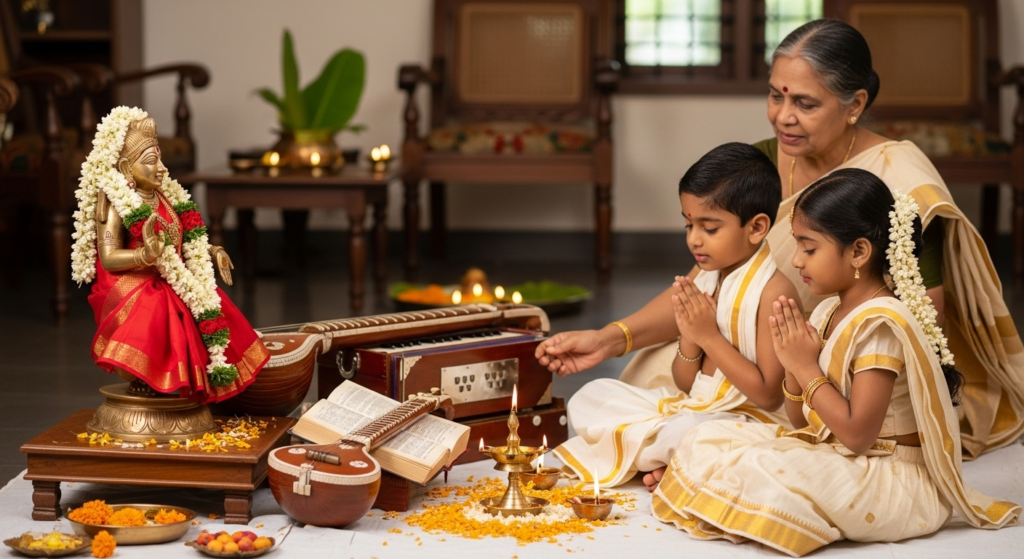
In Kerala, Navratri is focused on education and learning. During the last three days, books and musical instruments are placed before Goddess Saraswati for blessings. On Vijayadashami, children often start their formal education in a special ceremony called Vidyarambham.
Meaning & Purpose of Navratri Fasting
Navratri fasting (vrat) is more than just avoiding certain foods — it’s a spiritual discipline aimed at purifying the body, mind, and soul.
- It honours the nine forms of Goddess Durga over nine days.
- Fasting is believed to increase willpower, remove negative energies, and deepen your connection with the divine.
- It’s also a way to follow a satvik lifestyle — eating pure, light, and natural foods to keep the mind calm and focused.
Types of Navratri Fasts
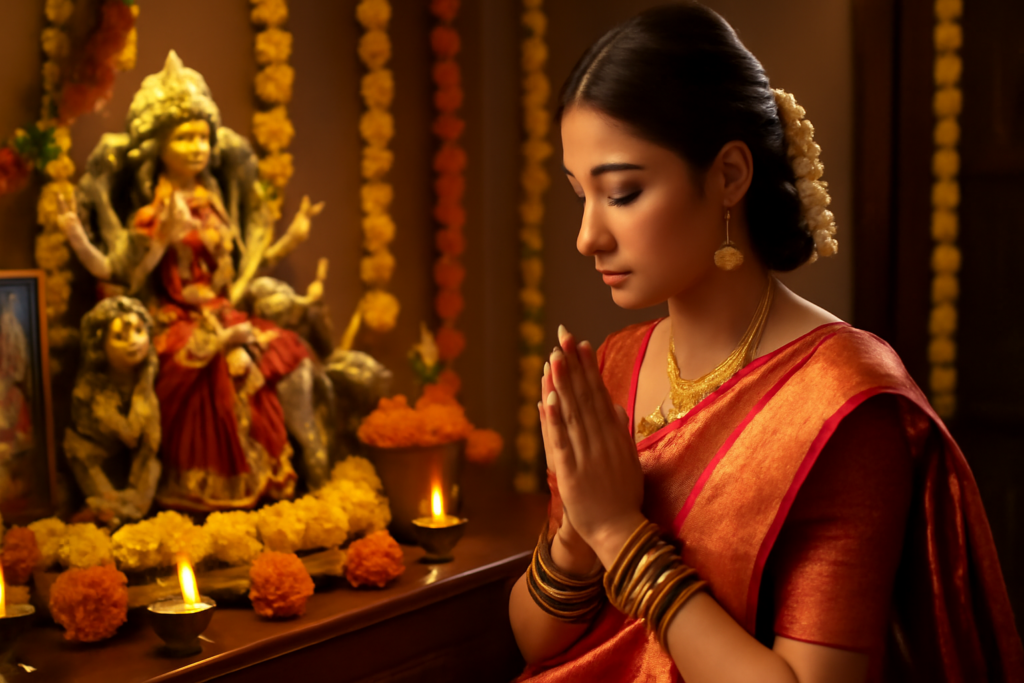
You can choose the type of fast based on your health, devotion, and tradition:
- Nirjal Fast – Only water is consumed (very strict).
- Phalahar Fast – Only fruits, milk, and permitted foods are eaten.
- Ek Bhojan – One full meal a day, usually after sunset.
- Partial Fast – Two light meals a day, both made with fasting-friendly ingredients.
General Rules & Rituals
- Begin with Ghatasthapana: Set up a Kalash (sacred pot) and invoke Goddess Durga.
- Daily Puja: Light a diya in the morning and evening, offer flowers, incense, and chant mantras like “Om Dum Durgaye Namah”.
- Avoid:
- Regular salt (use sendha namak / rock salt instead)
- Wheat, rice, lentils, onions, garlic, and non-vegetarian food
- Maintain purity: Keep your thoughts, words, and actions positive. Avoid anger, gossip, and negativity.
- End the fast: On the 8th or 9th day with Kanya Puja — worshipping nine young girls and offering them food and gifts.
Allowed Foods During Navratri
- Fruits: Banana, apple, papaya, pomegranate, grapes, etc.
- Flours: Buckwheat (kuttu ka atta), water chestnut (singhara atta), amaranth (rajgira atta).
- Vegetables: Potatoes, sweet potatoes, pumpkin, bottle gourd, and cucumber.
- Dairy: Milk, curd, paneer, ghee.
- Others: Sabudana (tapioca pearls), makhana (fox nuts), dry fruits, and honey.
- Spices: Rock salt, cumin, black pepper, green cardamom.
Foods to Avoid
- Wheat, rice, lentils, pulses
- Regular table salt
- Onion, garlic, mushrooms
- Meat, eggs, seafood
- Packaged or processed junk food.
Tips for a Healthy & Devotional Fast
- Stay hydrated with water, coconut water, or fresh juices.
- Eat small portions to maintain energy.
- Include nuts and milk for protein.
- Spend time in meditation, chanting, or reading Durga Saptashati.
- Offer the first portion of your food to the goddess before eating.
Navratri recipes
Popular Navratri Fasting Breakfast Options
1. Sabudana Khichdi
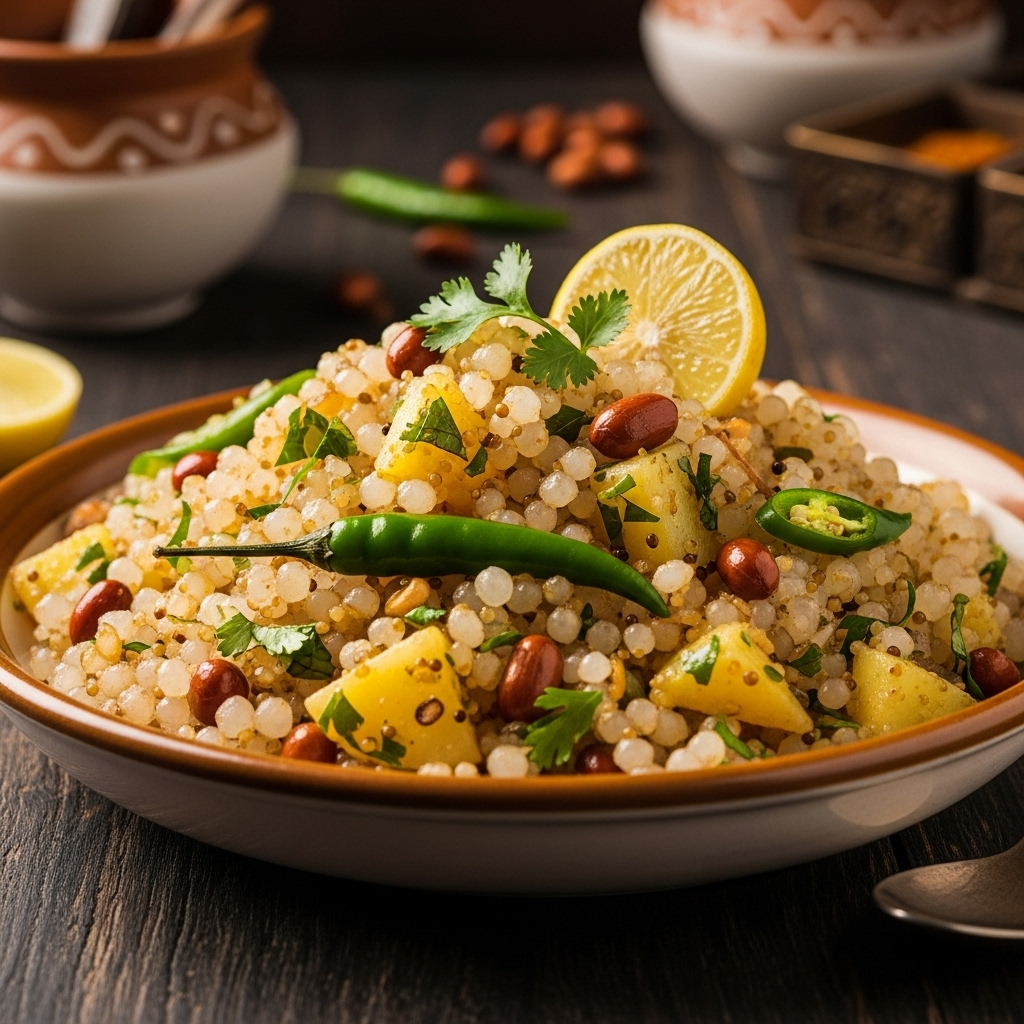
- Why: Rich in carbs for quick energy, peanuts add protein.
- Ingredients: Soaked sabudana, boiled potatoes, roasted peanuts, cumin, green chilli, and sendha namak.
- Tip: Cook on a low flame to keep pearls soft and non-sticky.
2. Makhana Kheer
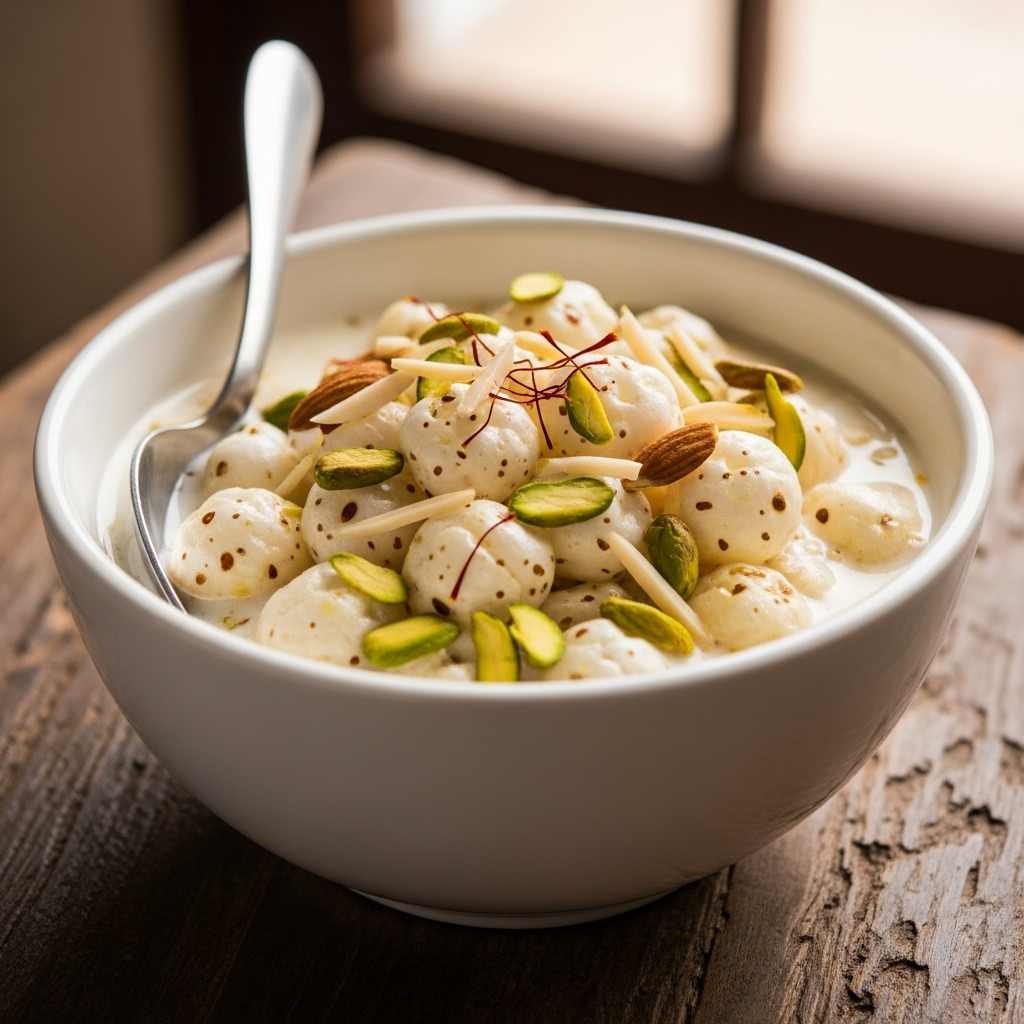
- Why: Light, creamy, and calcium-rich from milk.
- Ingredients: Roasted makhana, milk, cardamom, jaggery or sugar, dry fruits.
- Tip: Roast makhana in ghee before adding to milk for a nutty flavour.
3. Fruit & Dry Fruit Bowl
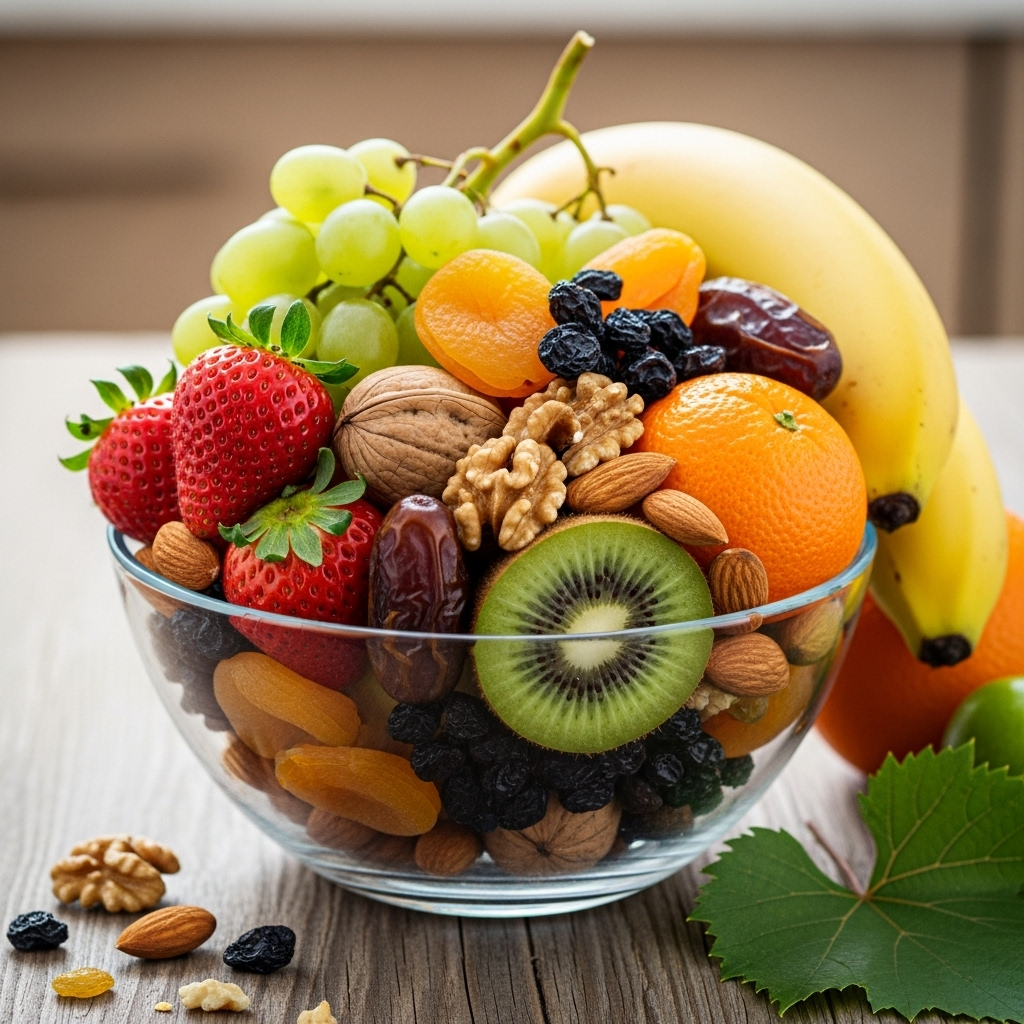
- Why: Natural sugars for instant energy, vitamins, and fibre.
- Ingredients: Banana, apple, papaya, pomegranate, soaked almonds, raisins, and honey drizzle.
- Tip: Avoid citrus fruits if you have acidity during fasting.
4. Rajgira (Amaranth) Sheera
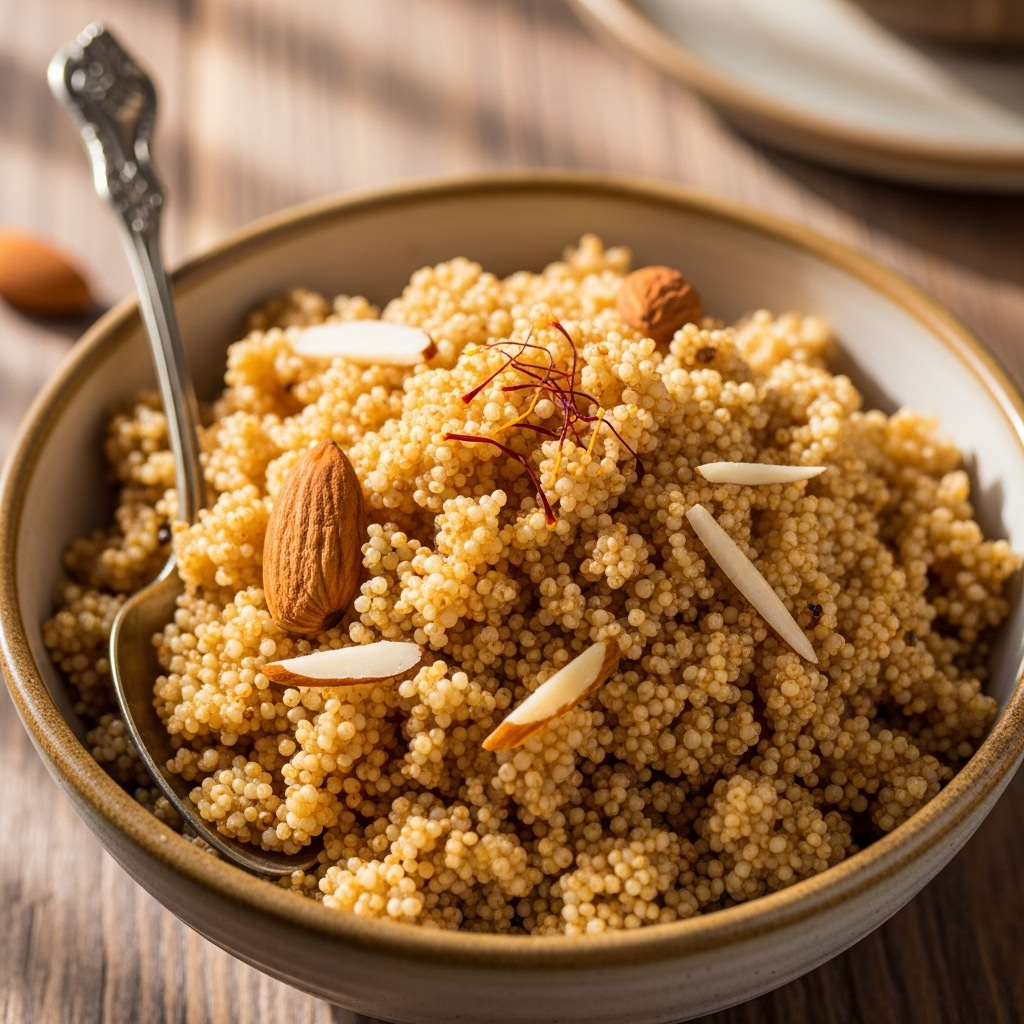
- Why: High in protein and iron, it keeps you full longer.
- Ingredients: Rajgira flour, ghee, jaggery, cardamom, water or milk.
- Tip: Roast flour well to avoid a raw taste.
5. Kuttu (Buckwheat) Pancakes
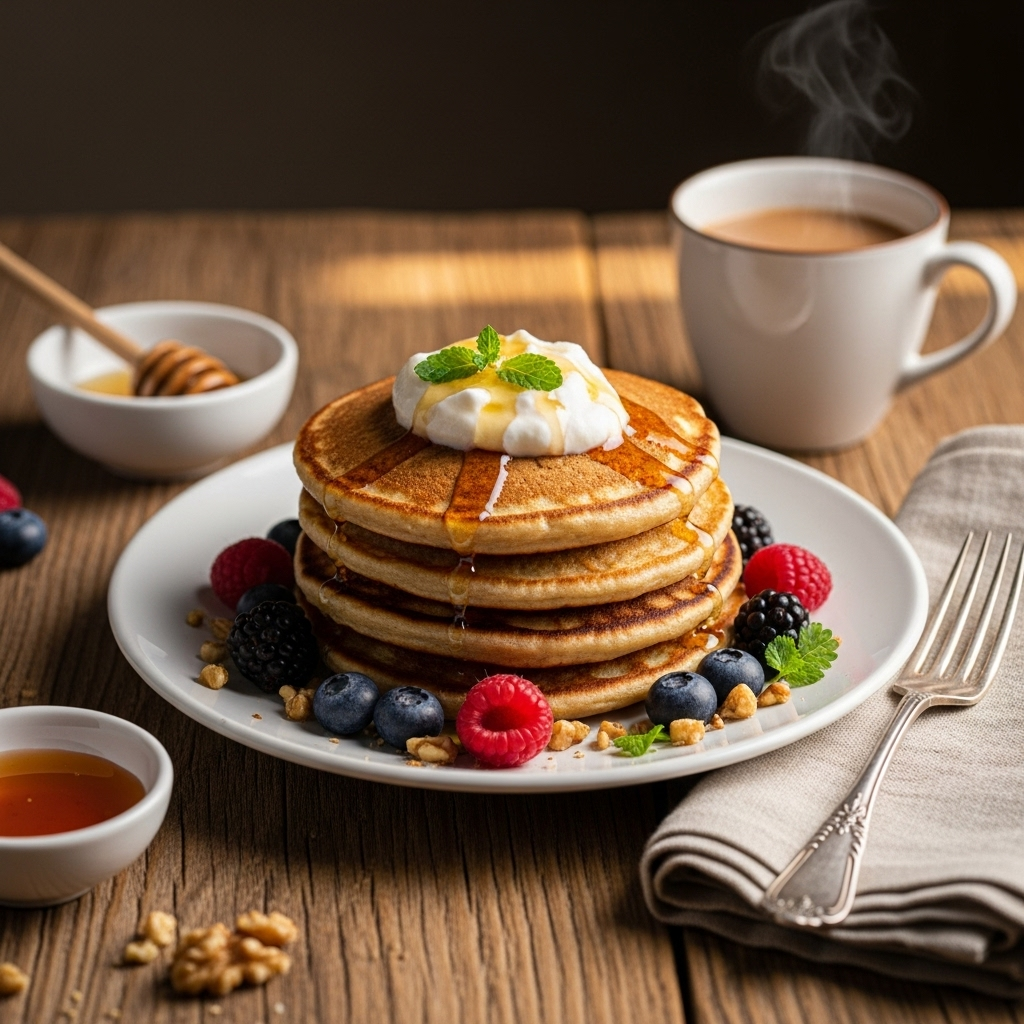
- Why: Gluten-free, filling, and versatile.
- Ingredients: Kuttu flour, mashed banana or boiled potato, sendha namak, cumin, ghee.
- Tip: Serve with curd or vrat-friendly chutney.
6. Smoothies & Lassi
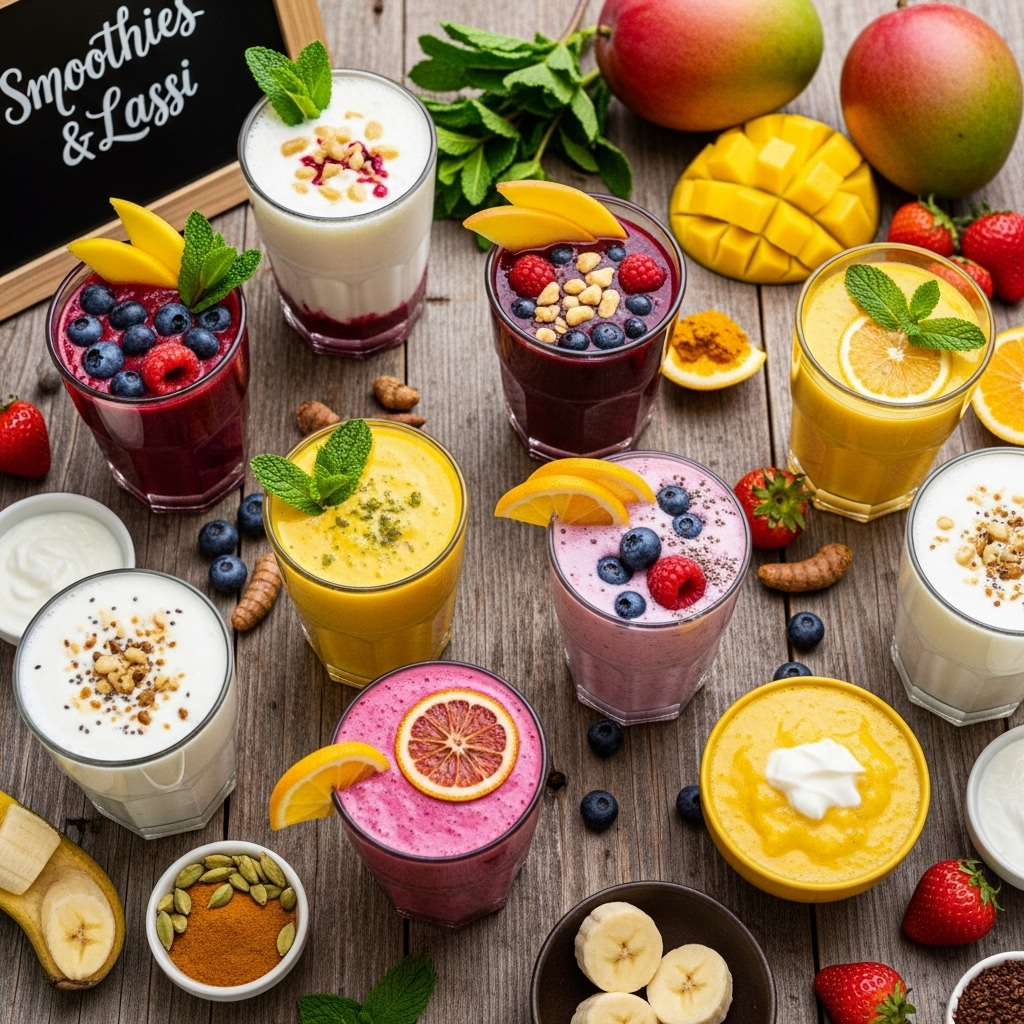
- Why: Hydrating and cooling, easy to digest.
- Ingredients: Milk or curd base with banana, chikoo, or mango (seasonal), cardamom, and honey.
- Tip: Add soaked chia seeds for extra fibre.
Breakfast Planning Tips for Navratri
- Hydrate first: Start your day with warm water or lemon-honey water (if allowed in your vrat).
- Balance: Include carbs (sabudana, samak), protein (nuts, paneer), and healthy fats (ghee, coconut).
- Portion control: Eat enough to stay energised but avoid heaviness that makes puja uncomfortable.
- Freshness: Prepare meals fresh each morning — avoid reheating vrat food multiple times.
Purpose of a Navratri Lunch During Fasting
- Lunch is the main sustaining meal of the day during Navratri fasts.
- It should be light yet filling, easy to digest, and made with vrat-friendly ingredients.
- The focus is on satvik food — pure, vegetarian, and free from onion, garlic, wheat, rice, and regular salt.
Popular Navratri Lunch Dishes & Details
1. Samak Rice (Barnyard Millet) Khichdi
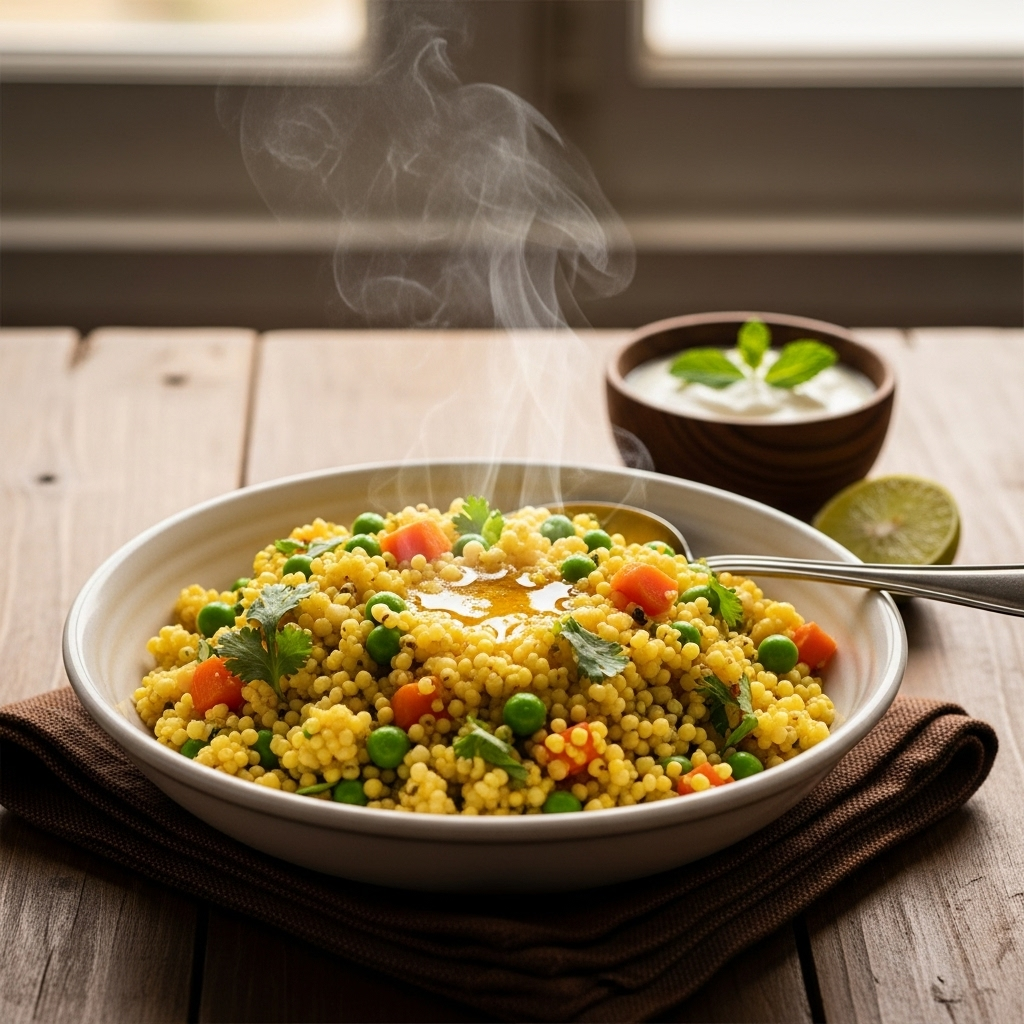
- Why: A perfect rice substitute, gluten-free, and light on the stomach.
- Ingredients: Samak rice, boiled potatoes, peanuts, cumin, green chilli, ghee, rock salt (sendha namak).
- Tip: Serve with plain curd or cucumber raita for a cooling effect.
2. Kuttu (Buckwheat) or Singhara (Water Chestnut) Roti with Aloo Tamatar Sabzi
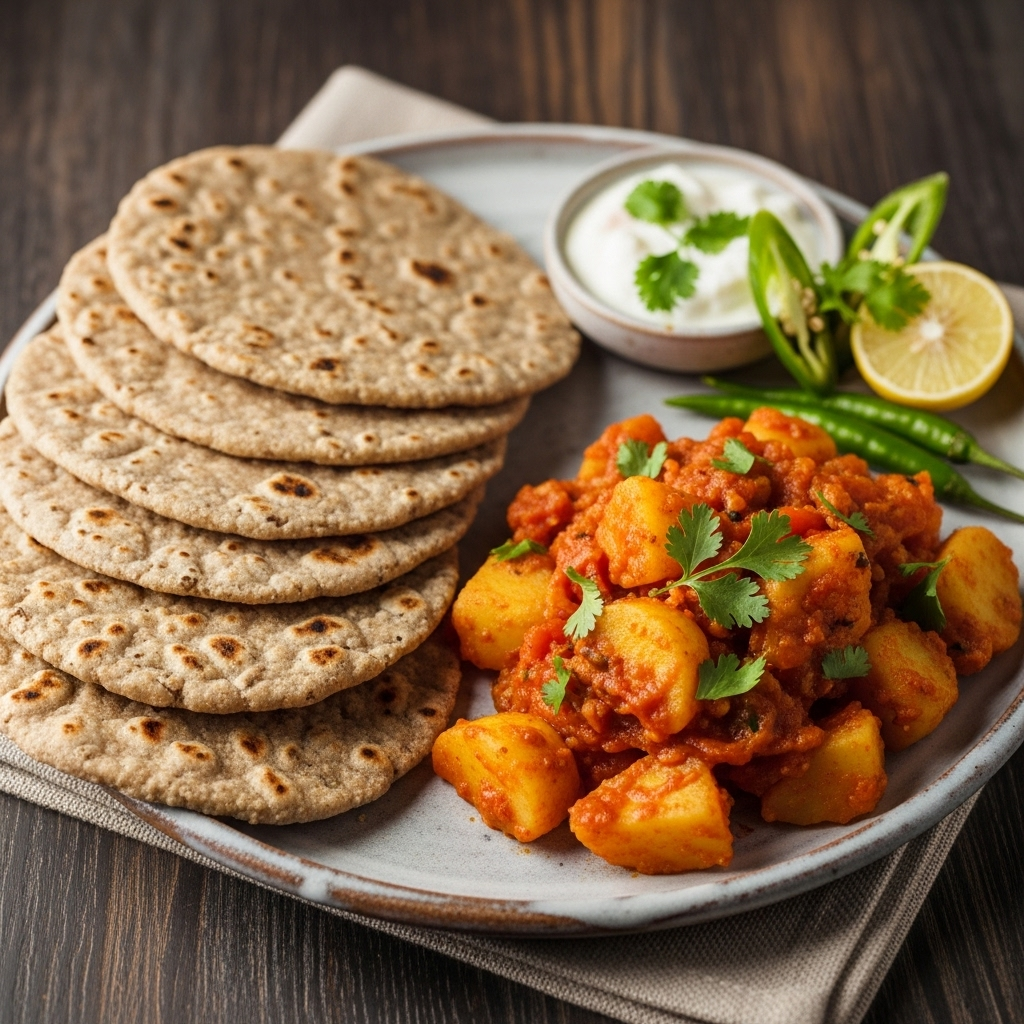
- Why: Provides complex carbs and energy for the day.
- Ingredients: Kuttu or singhara flour, boiled potatoes, rock salt, cumin; curry made with tomatoes, potatoes, and mild spices.
- Tip: Add a spoonful of ghee on hot rotis for better digestion.
3. Paneer Makhana Curry
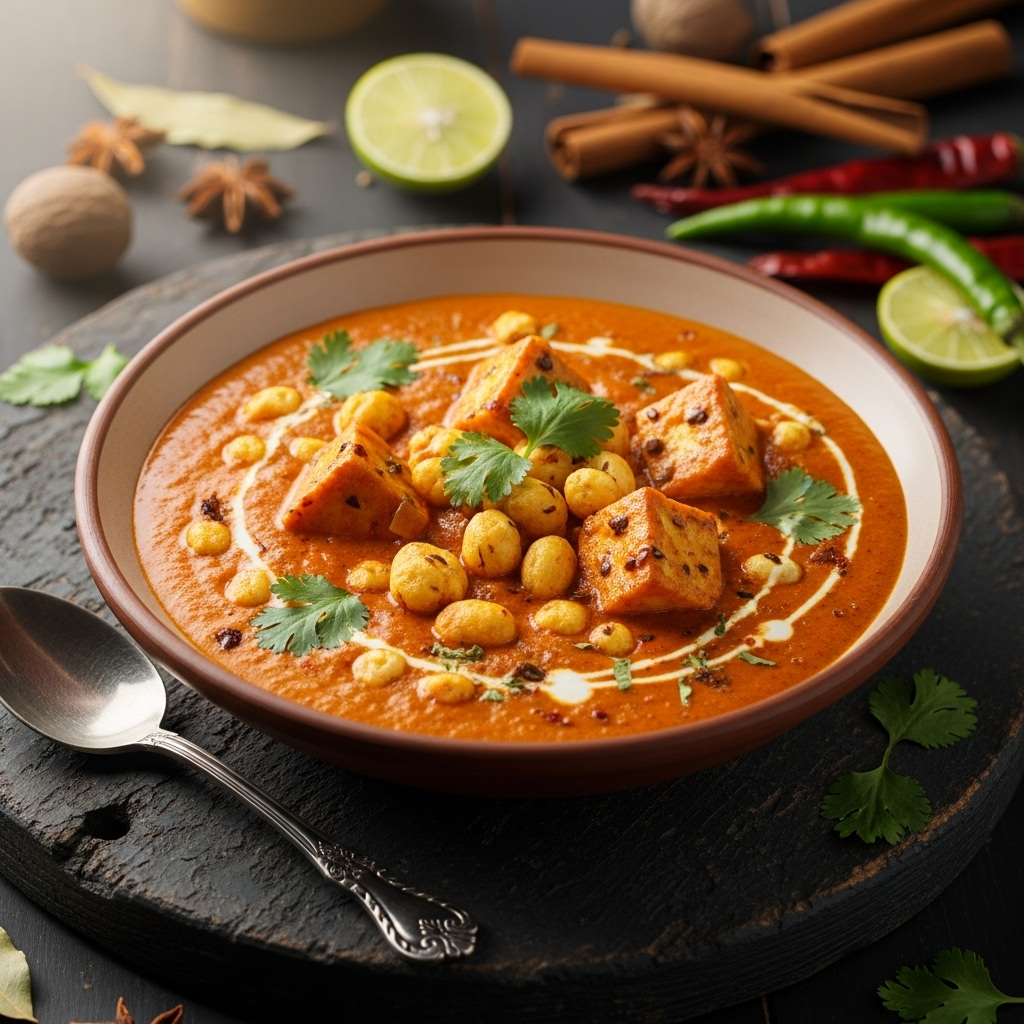
- Why: High in protein and calcium, keeps you full longer.
- Ingredients: Paneer cubes, roasted makhana, tomato puree (if allowed), ginger, green chilli, rock salt.
- Tip: Lightly roast makhana before adding to curry for a nutty flavour.
4. Lauki (Bottle Gourd) Curry with Rajgira Poori
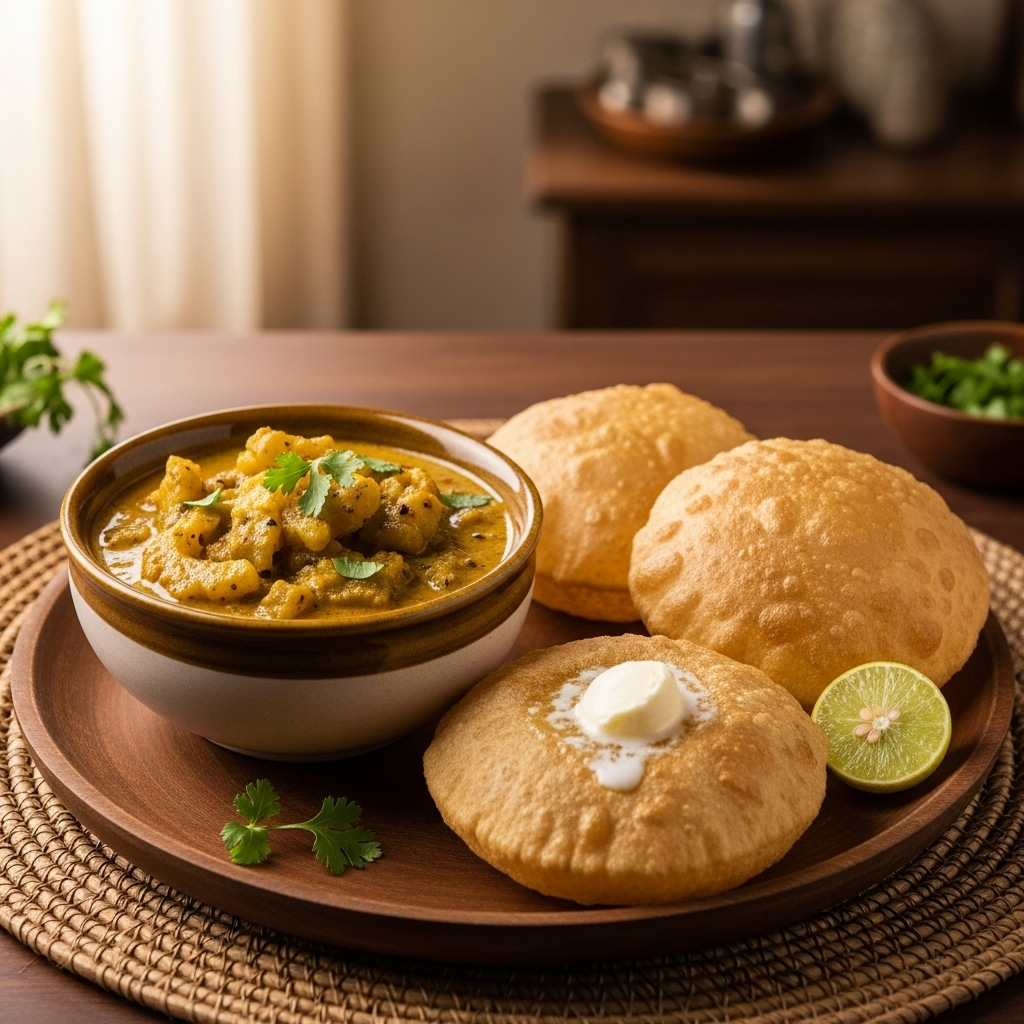
- Why: Lauki is hydrating and easy to digest; rajgira flour is rich in iron and protein.
- Ingredients: Bottle gourd, cumin, green chilli, rock salt, rajgira flour, ghee.
- Tip: Keep curry mildly spiced to avoid acidity during fasting.
5. Sweet Potato Chaat
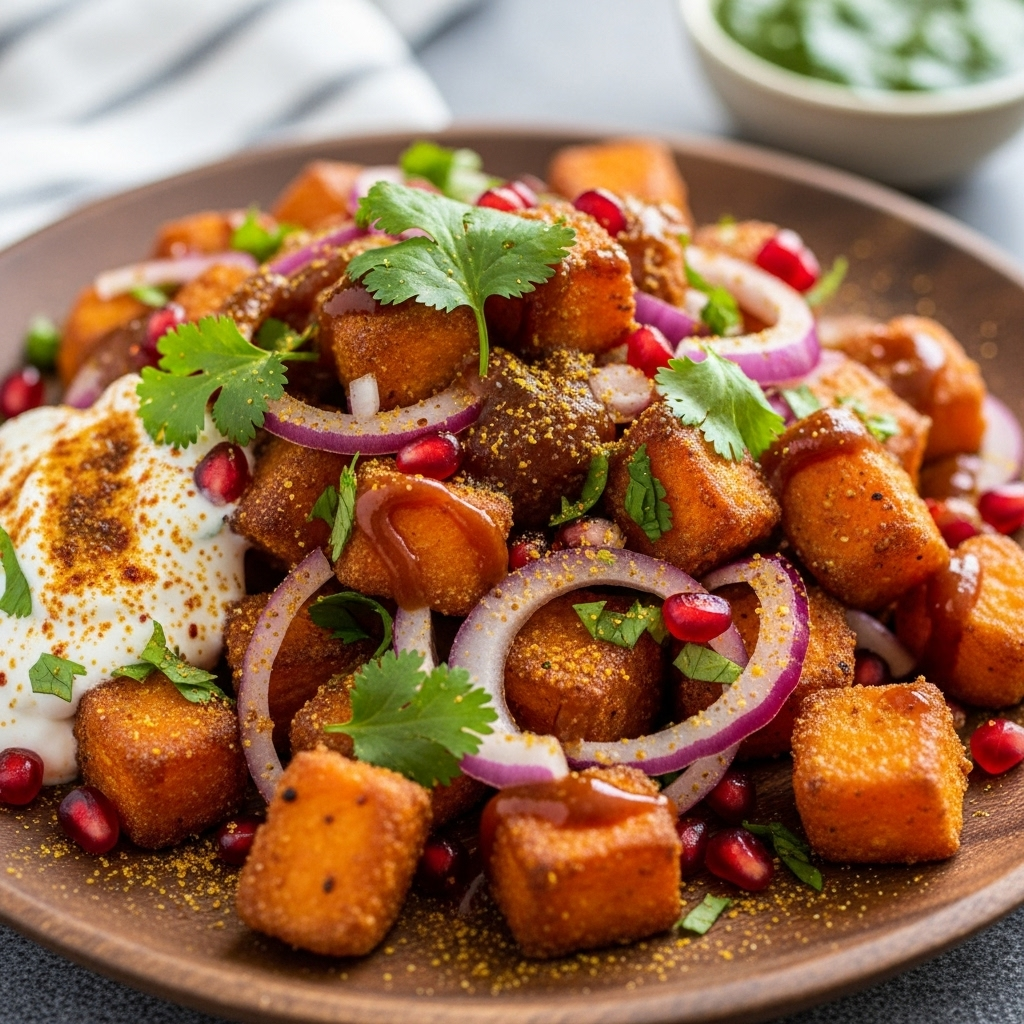
- Why: Naturally sweet, rich in fibre, and a great energy booster.
- Ingredients: Boiled sweet potatoes, rock salt, lemon juice, chopped coriander, black pepper.
- Tip: Can be eaten warm or chilled.
6. Arbi (Colocasia) Curry with Singhara Roti
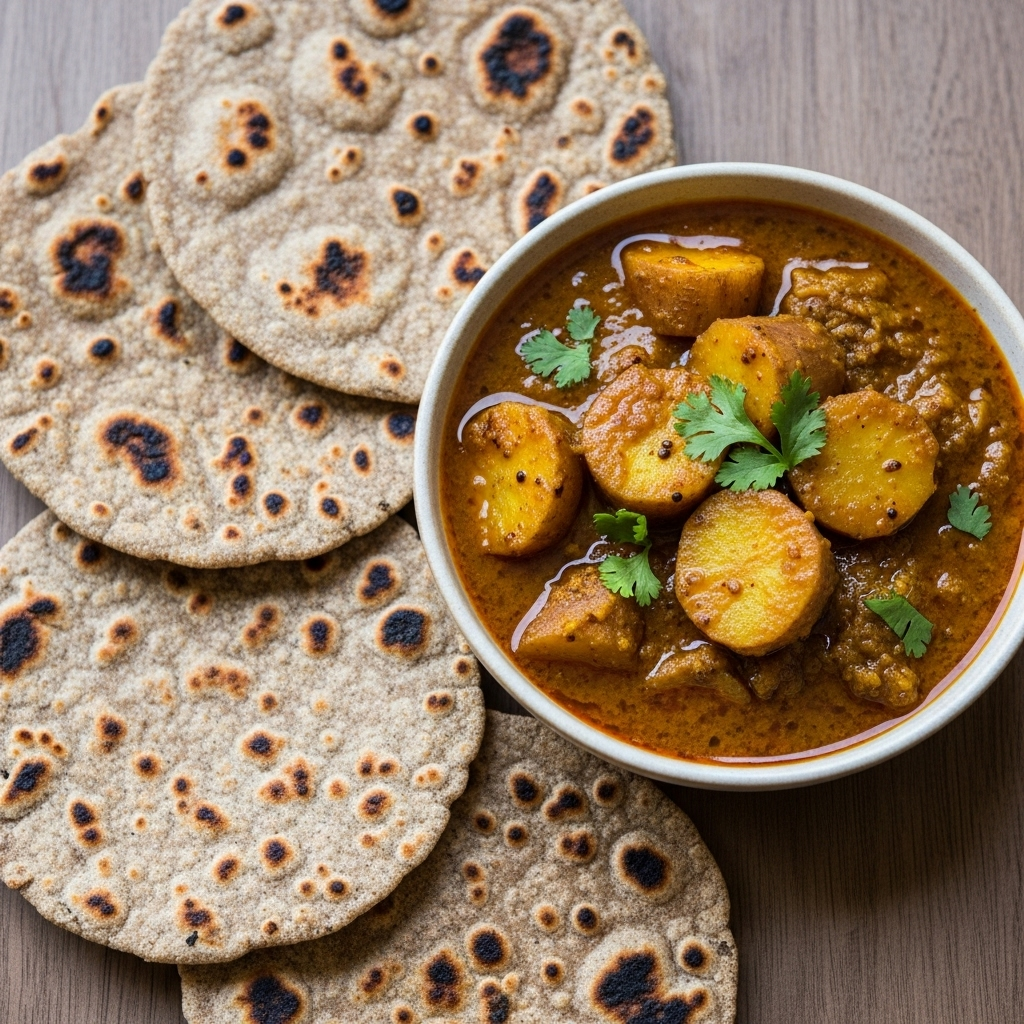
- Why: Arbi is filling and provides slow-release energy.
- Ingredients: Boiled arbi, cumin, green chilli, rock salt, and coriander leaves.
- Tip: Avoid deep frying to keep it light.
7. Sabudana Khichdi
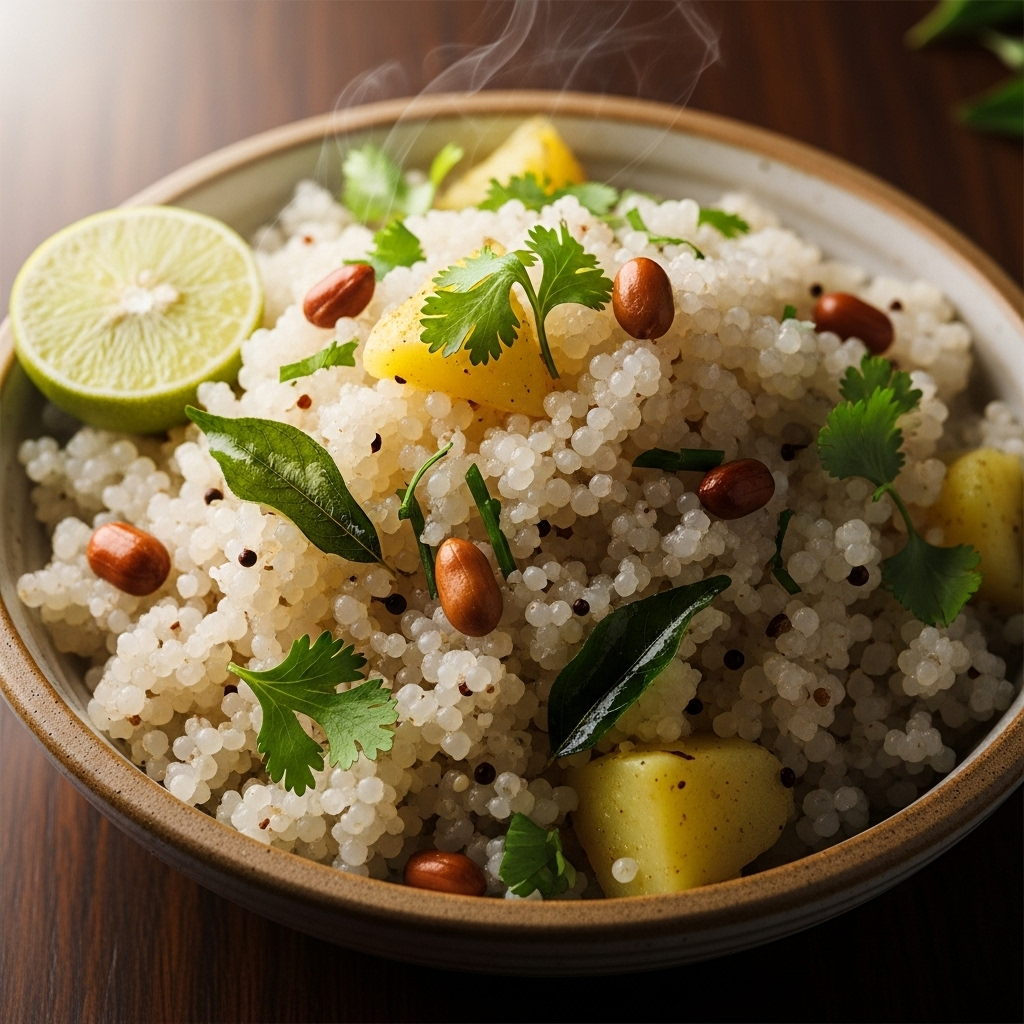
- Why: A classic vrat dish, rich in carbs for quick energy.
- Ingredients: Soaked sabudana, boiled potatoes, roasted peanuts, cumin, green chilli, rock salt.
- Tip: Cook on a low flame to keep sabudana pearls separate and non-sticky.
Side Dishes & Accompaniments
- Raita: Cucumber, bottle gourd, or mint raita with rock salt.
- Salads: Cucumber, tomato, carrot with lemon dressing.
- Papad: Rajgira or sabudana papad for crunch.
Lunch Planning Tips for Navratri
- Balance carbs + protein + healthy fats for steady energy.
- Use ghee in moderation for flavour and digestion.
- Drink buttermilk or coconut water alongside to stay hydrated.
- Avoid overly spicy or oily food to prevent heaviness during puja.
Why Snacks Are Important During Navratri Fasting
- They help maintain steady energy levels between main meals.
- Prevents overeating at lunch or dinner.
- Keeps the metabolism active while following satvik (pure, light, vegetarian) food rules.
Popular Navratri Fasting Snacks & Details
1. Sabudana Vada
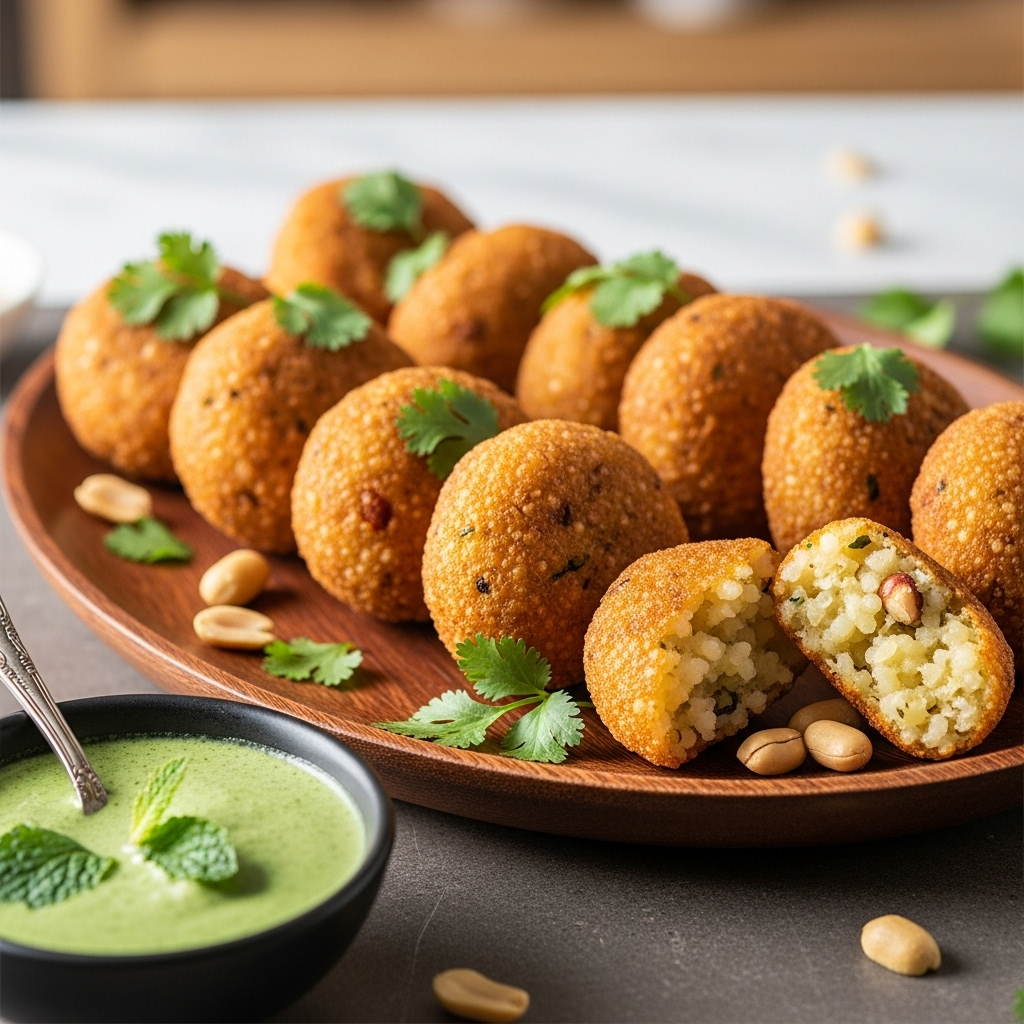
- Why: Crispy outside, soft inside — a filling, protein-rich snack.
- Ingredients: Soaked sabudana, boiled potatoes, roasted peanuts, green chilli, rock salt (sendha namak).
- Tip: Shallow fry in ghee for a lighter version.
2. Roasted Makhana (Fox Nuts)
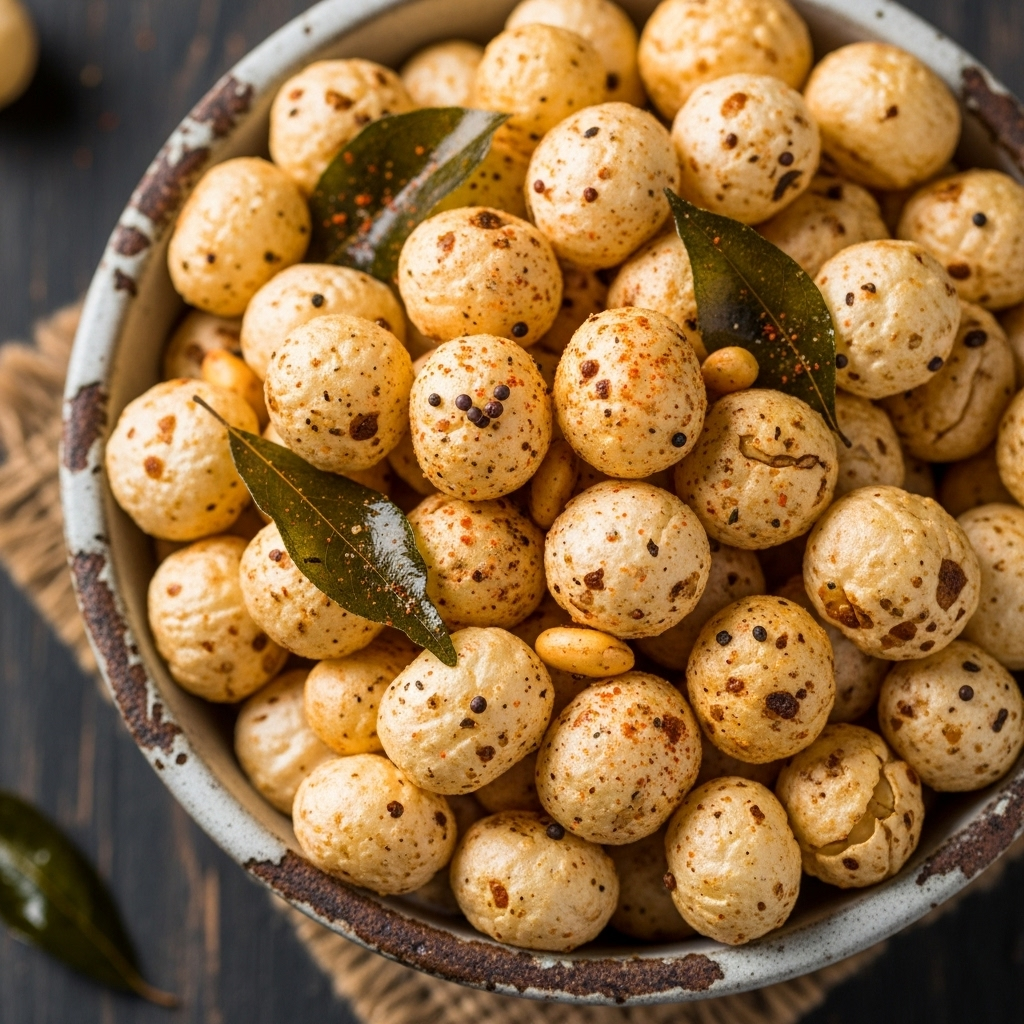
- Why: Light, crunchy, and rich in calcium.
- Ingredients: Makhana, ghee, rock salt, black pepper.
- Tip: Roast on low flame for even crispiness.
3. Aloo Paneer Tikki
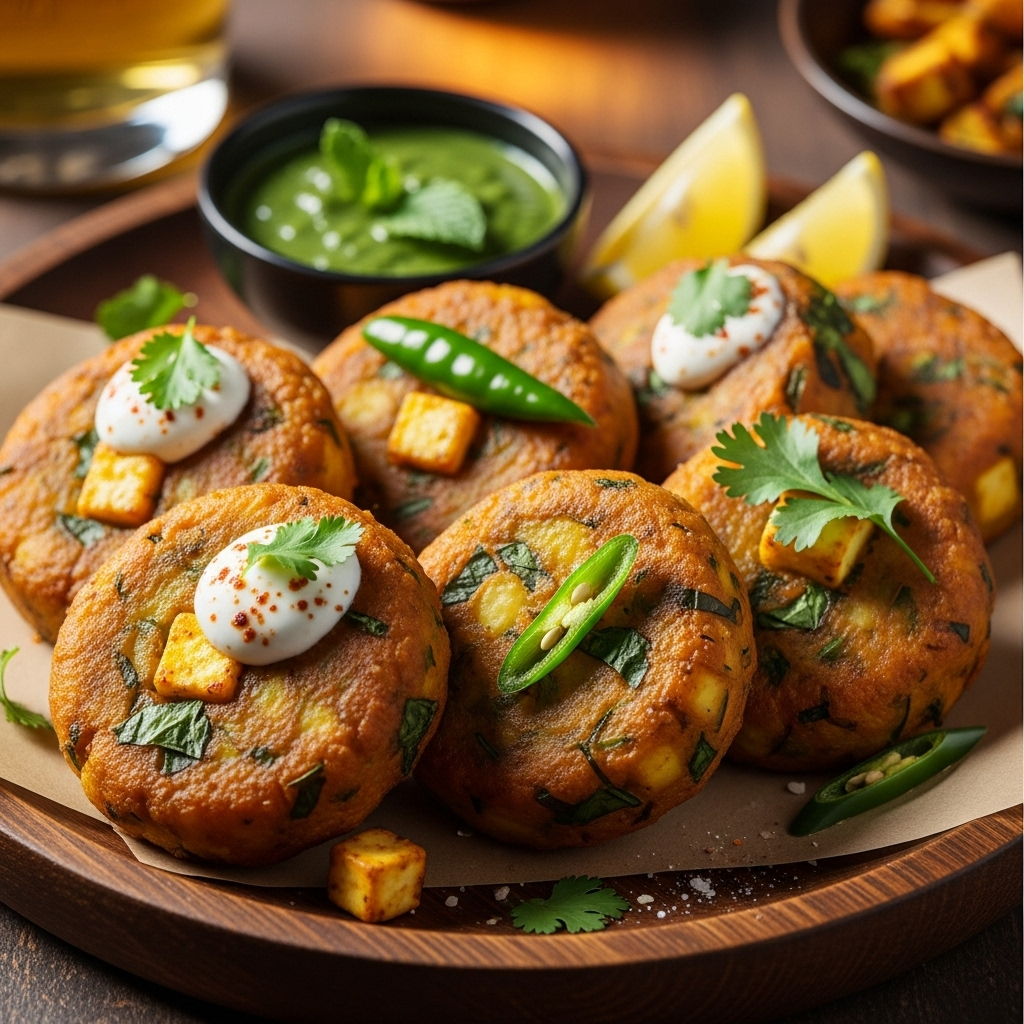
- Why: High in protein and carbs, keeps you full longer.
- Ingredients: Boiled potatoes, grated paneer, green chilli, coriander, rock salt.
- Tip: Pan-fry instead of deep-frying for a healthier option.
4. Rajgira Ladoo
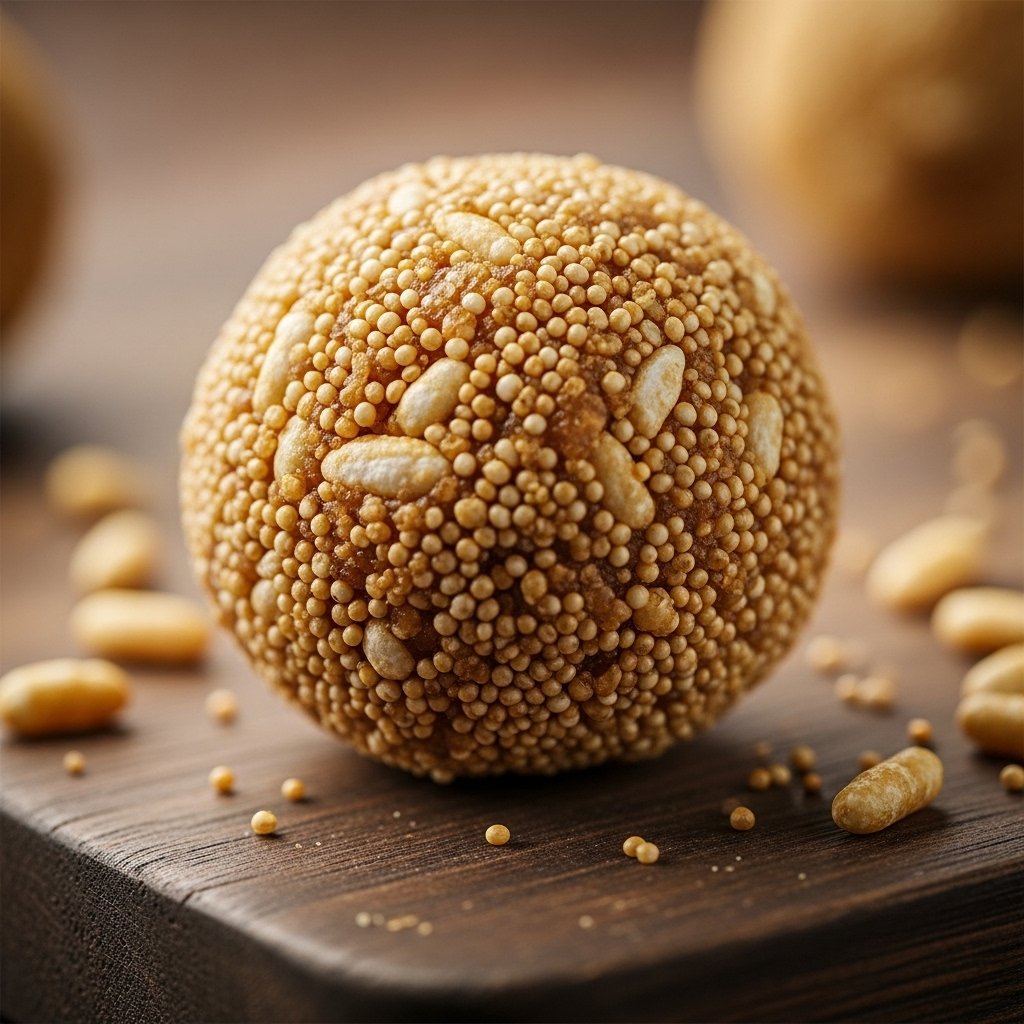
- Why: Sweet, energy-boosting, and rich in iron.
- Ingredients: Popped amaranth, jaggery, ghee.
- Tip: Store in an airtight jar for a quick grab-and-go snack.
5. Sweet Potato Chaat
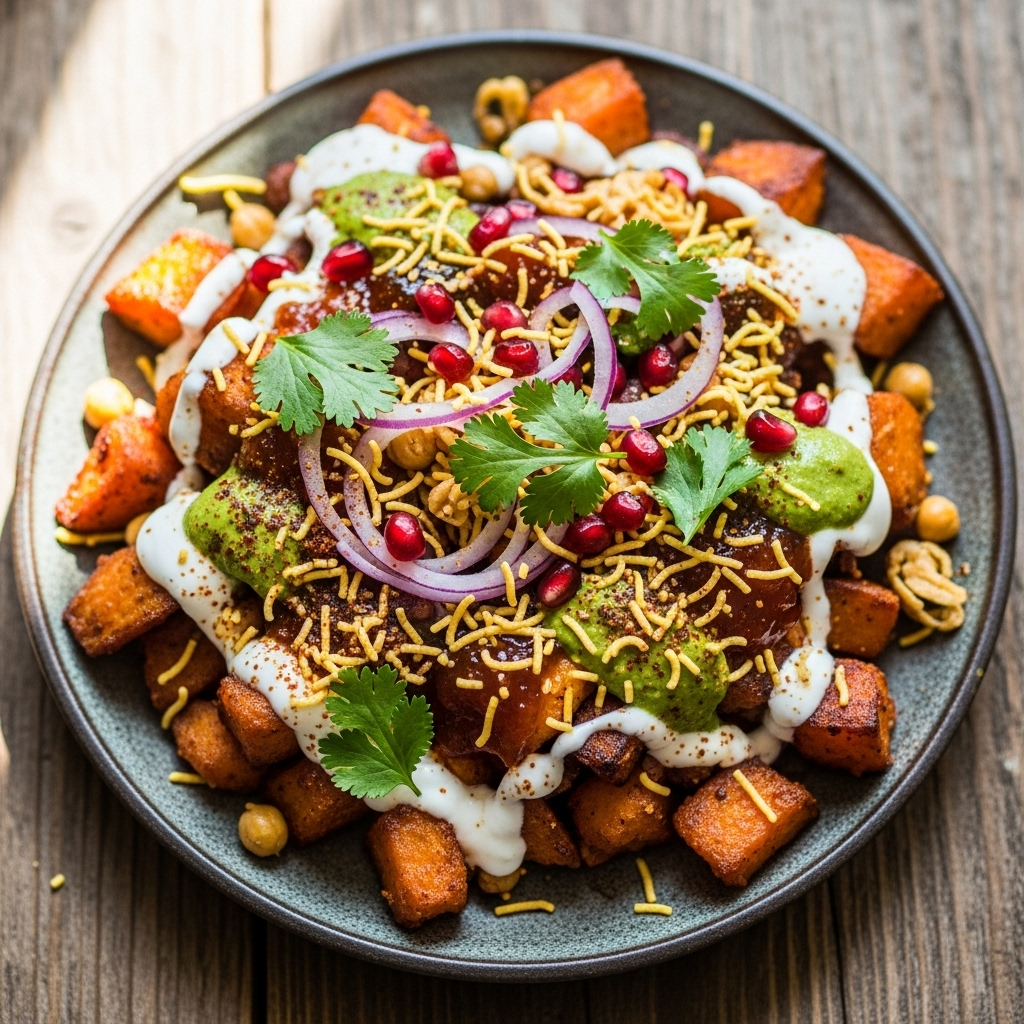
- Why: Naturally sweet, fibre-rich, and easy to digest.
- Ingredients: Boiled sweet potatoes, lemon juice, rock salt, black pepper, coriander.
- Tip: Add pomegranate seeds for extra freshness.
6. Falahari Dhokla
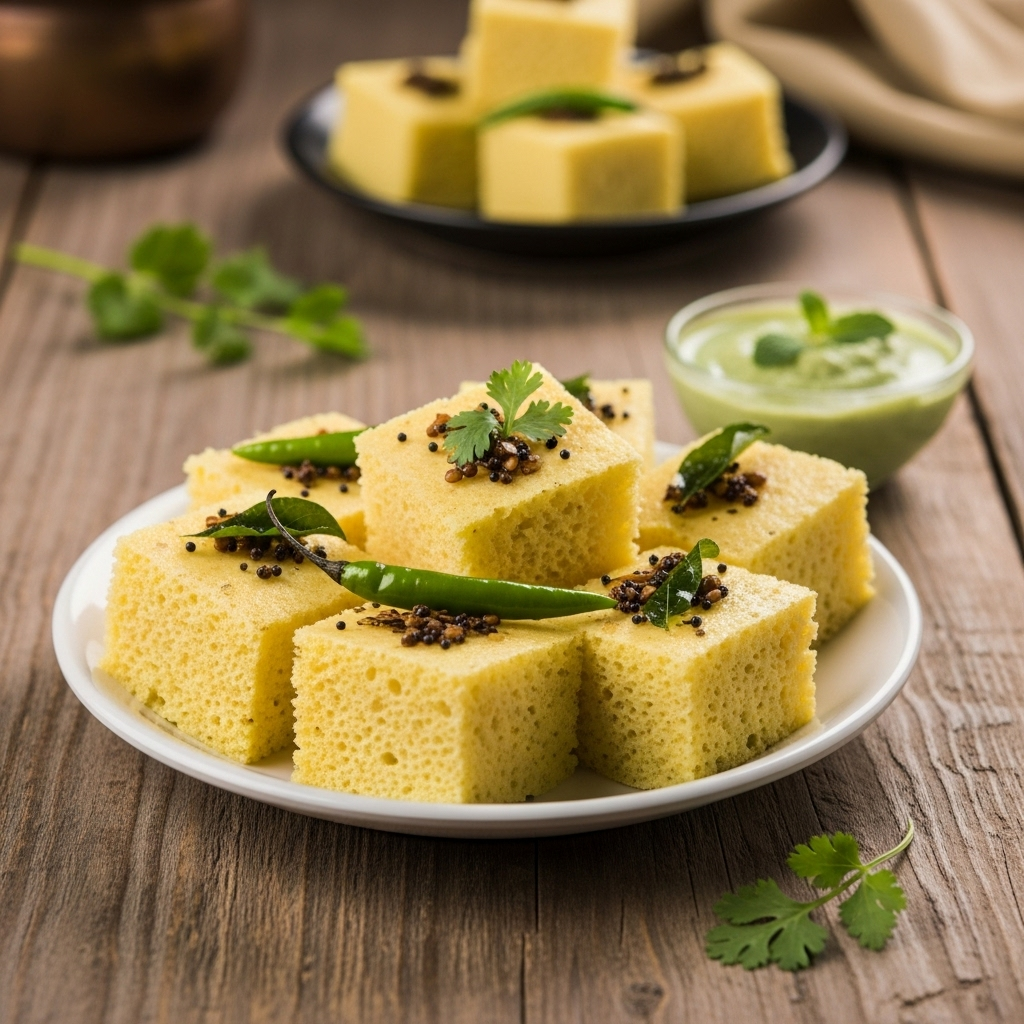
- Why: Steamed, light, and gut-friendly.
- Ingredients: Sama rice flour, curd, rock salt, green chilli paste.
- Tip: Steam just before serving for the best texture.
7. Dry Fruit Mix
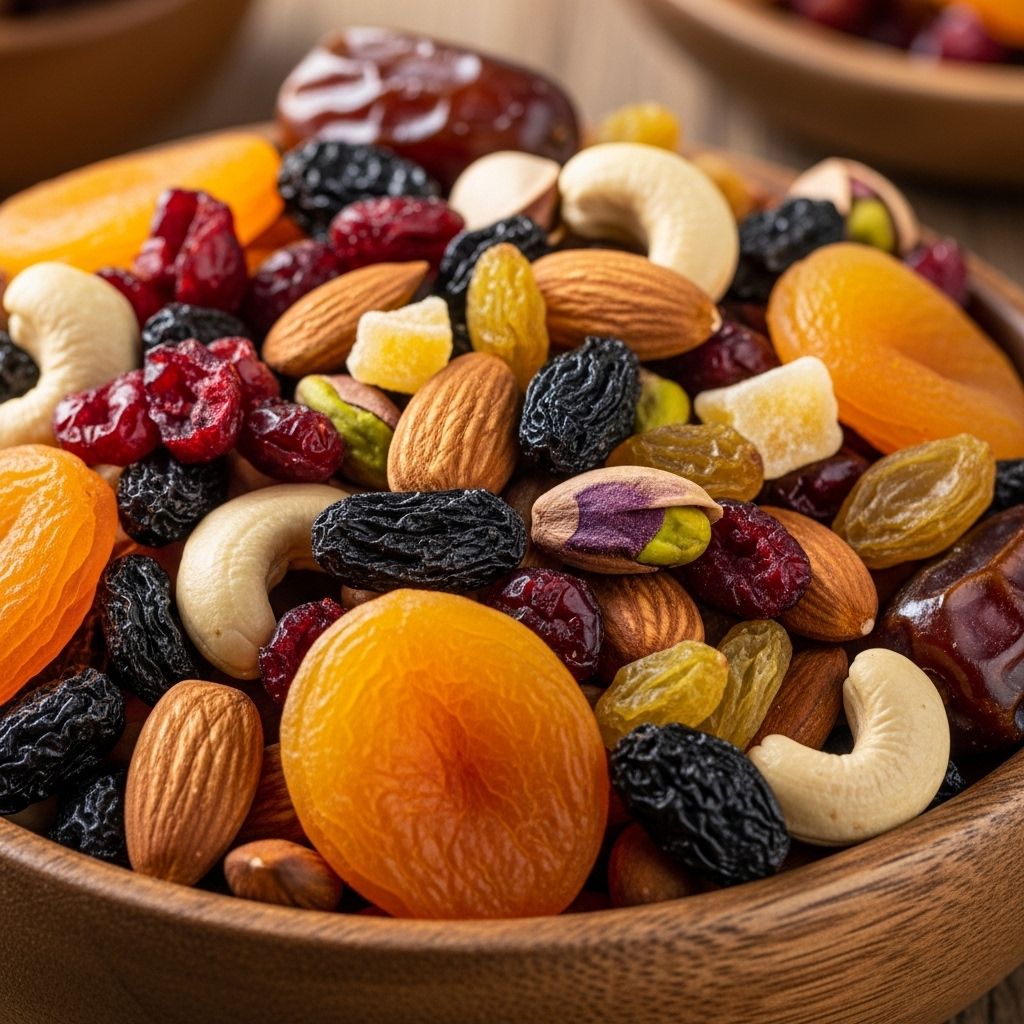
- Why: Instant energy and nutrient-dense.
- Ingredients: Almonds, cashews, raisins, walnuts, pistachios.
- Tip: Lightly roast in ghee with a pinch of rock salt for flavour.
8. Coconut Ladoo
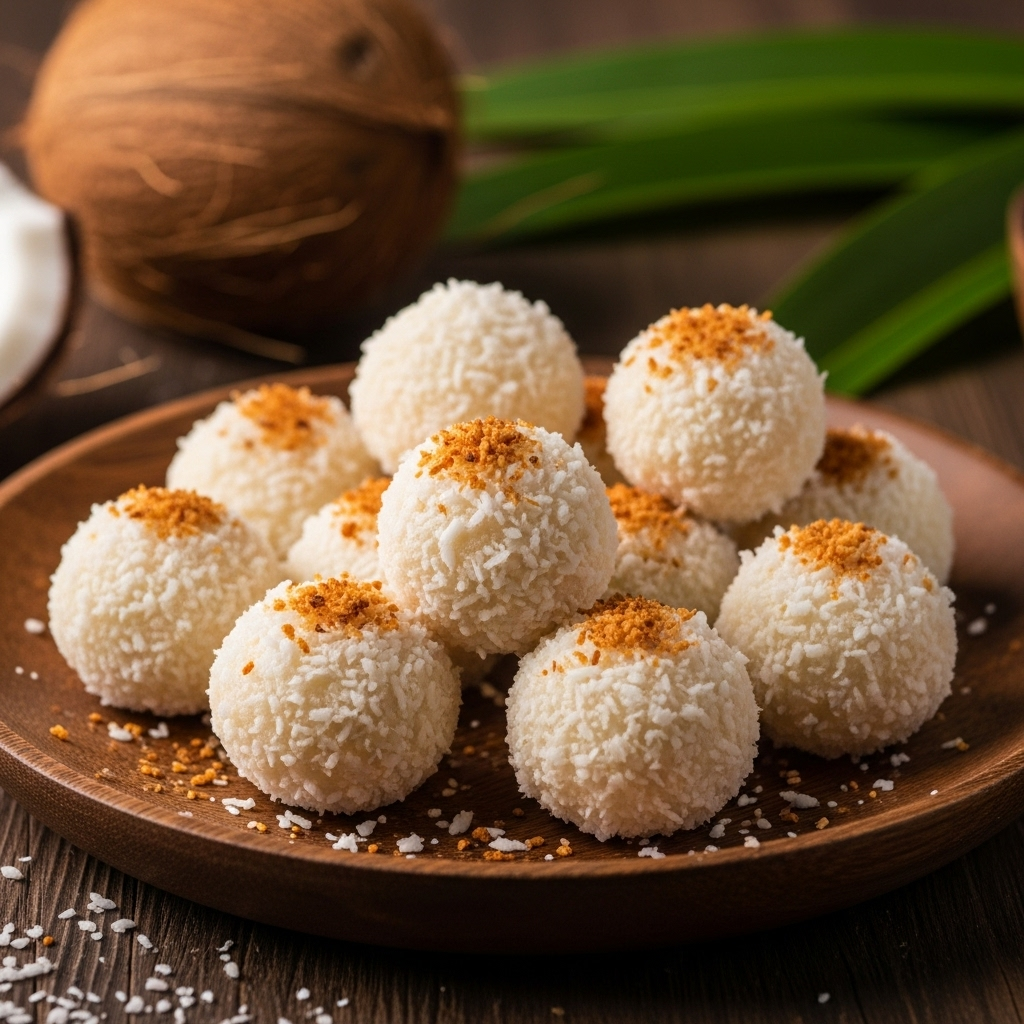
- Why: Sweet, aromatic, and quick to make.
- Ingredients: Fresh grated coconut, condensed milk or jaggery, cardamom.
- Tip: Roll in dry coconut powder for a festive look.
9. Fruit & Yoghurt Bowl
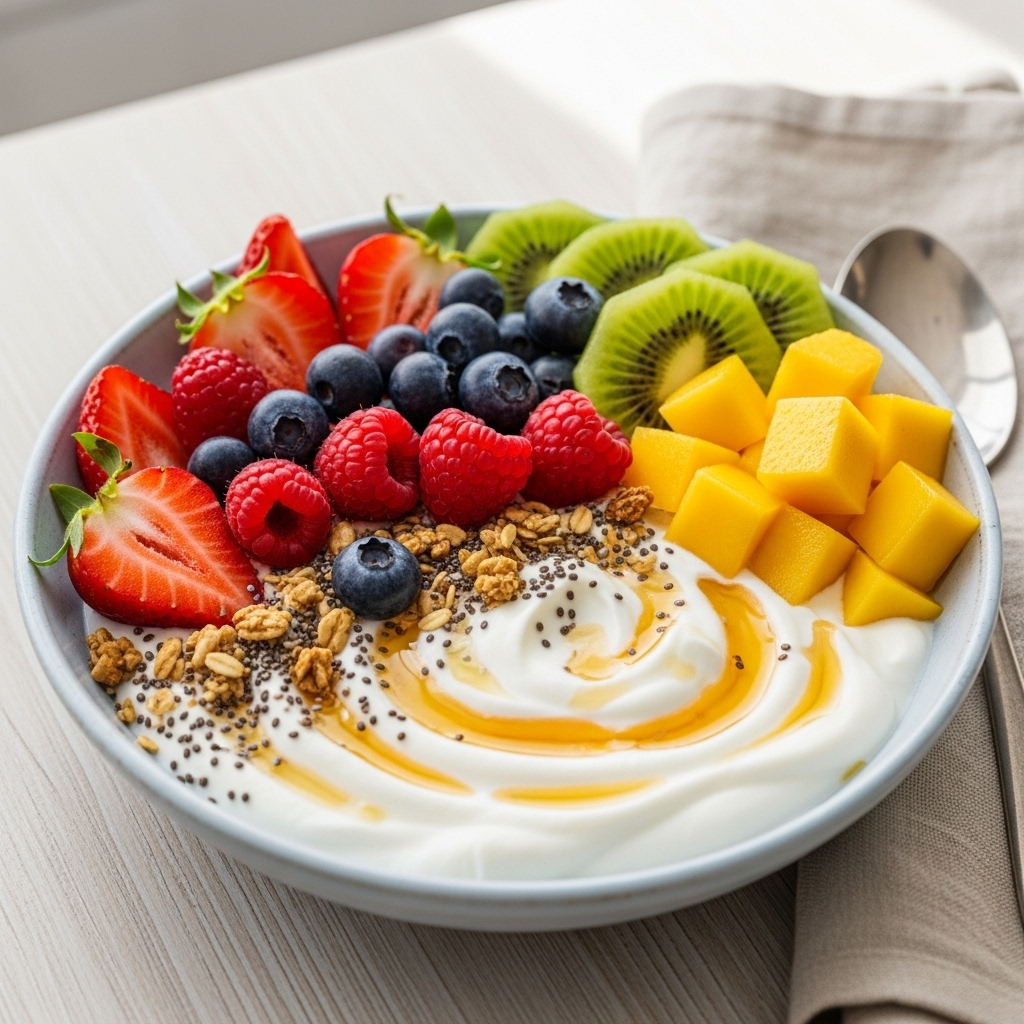
- Why: Cooling, hydrating, and vitamin-rich.
- Ingredients: Banana, apple, papaya, pomegranate, chilled curd, and honey.
- Tip: Sprinkle with roasted flax or chia seeds (if allowed).
Snacking Tips for Navratri
- Use sendha namak instead of regular salt.
- Avoid heavy frying daily — balance with roasted or steamed snacks.
- Keep portions small to avoid feeling sluggish during puja.
- Stay hydrated with coconut water, herbal teas, or lemon water between snacks.
Purpose of a Navratri Dinner
- Dinner during Navratri should be light, easy to digest, and nourishing so your body can rest well overnight.
- It’s best to avoid heavy fried foods late in the day to prevent bloating or discomfort during early morning puja.
- Meals are satvik — pure vegetarian, without onion, garlic, wheat, rice, or regular salt.
Popular Navratri Dinner Dishes & Details
1. Sabudana Khichdi
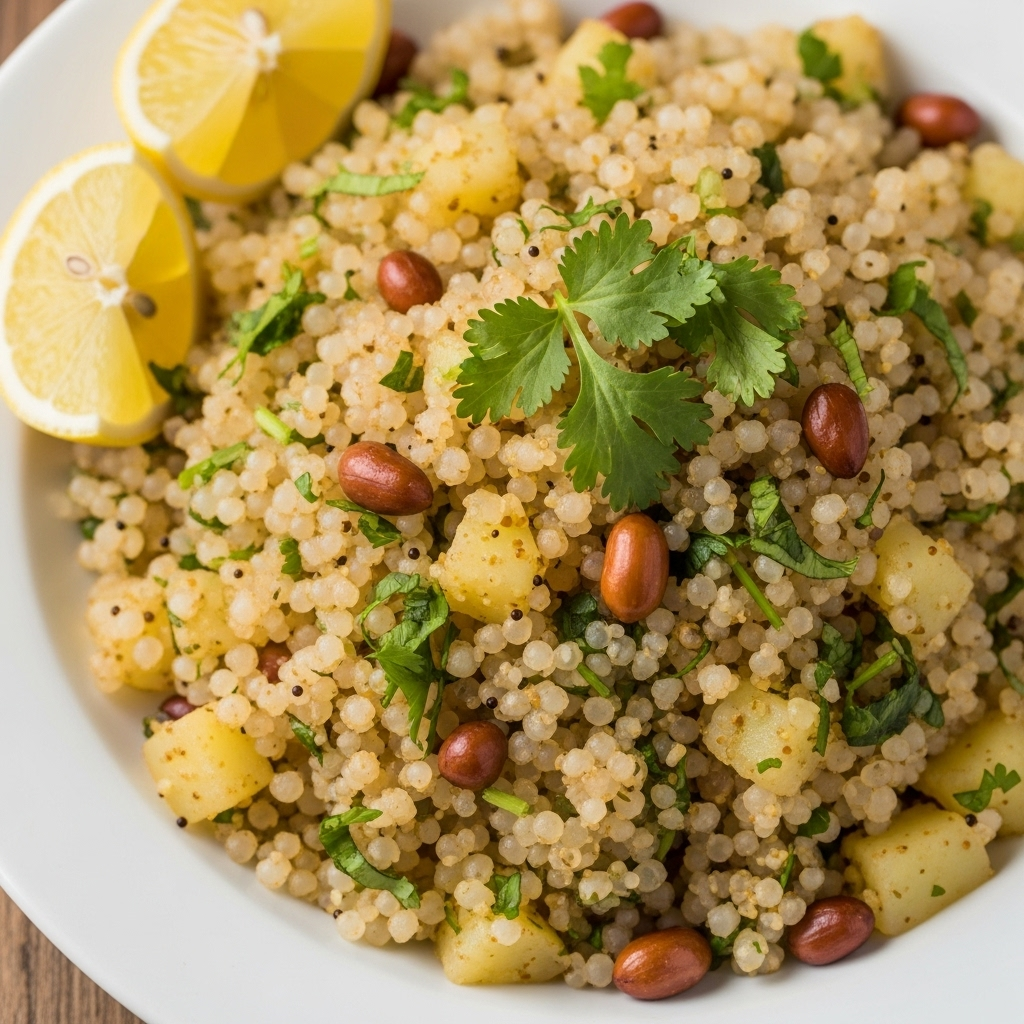
- Why: Gentle on the stomach, rich in carbs for quick energy.
- Ingredients: Soaked sabudana, boiled potatoes, roasted peanuts, cumin, green chilli, rock salt (sendha namak).
- Tip: Cook on low flame until pearls turn translucent; garnish with coriander.
2. Samak Rice Pulao
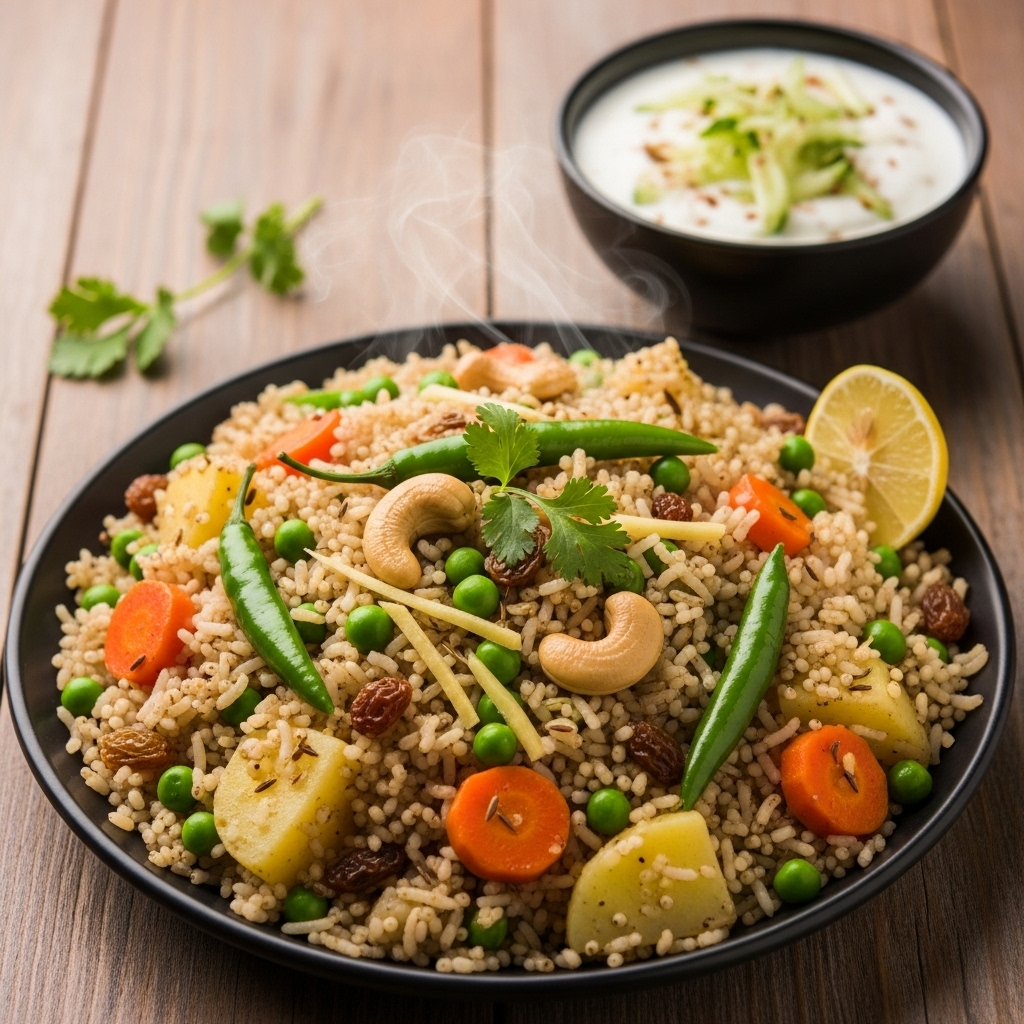
- Why: A wholesome rice alternative that’s gluten-free and light.
- Ingredients: Samak rice, diced vegetables (like bottle gourd, carrots, or pumpkin), cumin, ghee, rock salt.
- Tip: Pair with cucumber raita for a cooling effect.
3. Kuttu (Buckwheat) Cheela
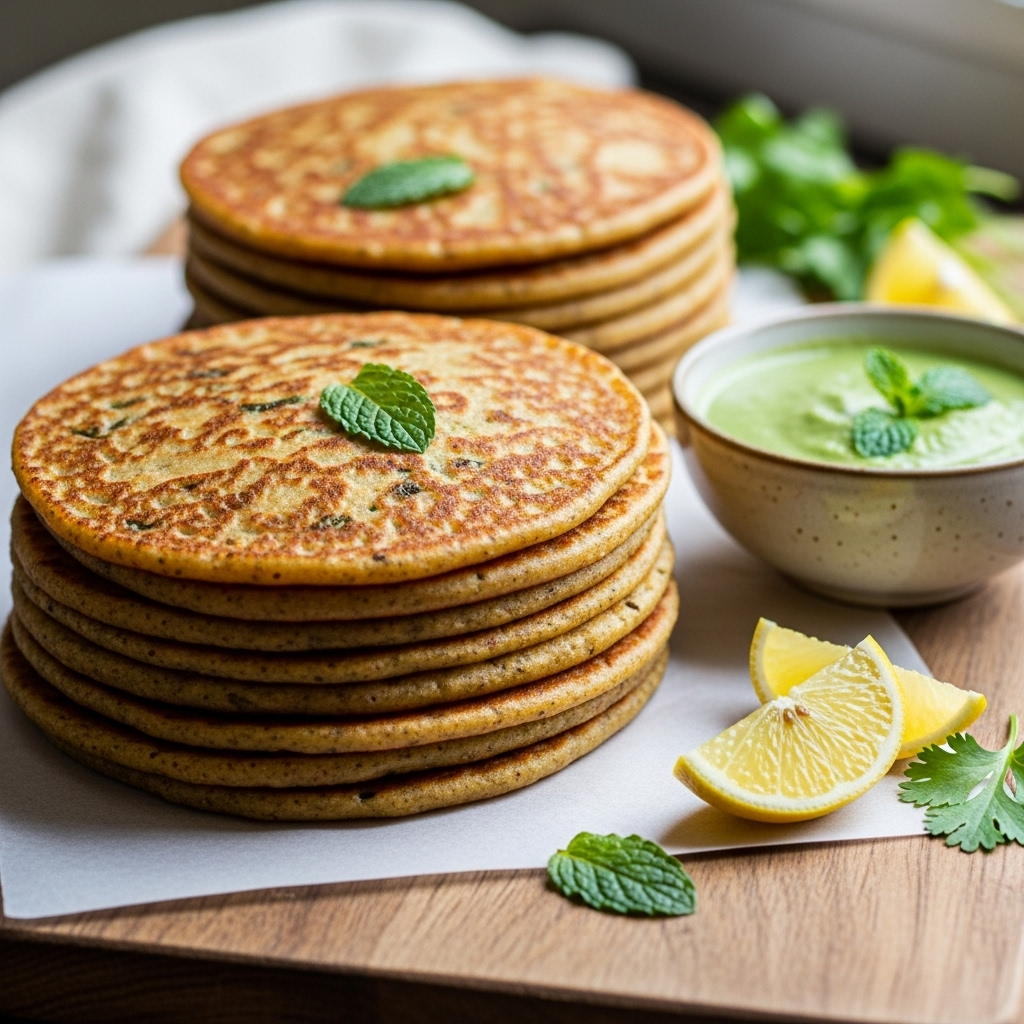
- Why: High in protein and fibre, keeps you full without heaviness.
- Ingredients: Kuttu flour, grated bottle gourd or potato, green chilli, coriander, rock salt.
- Tip: Serve with vrat-friendly coconut or mint chutney.
4. Paneer & Makhana Curry
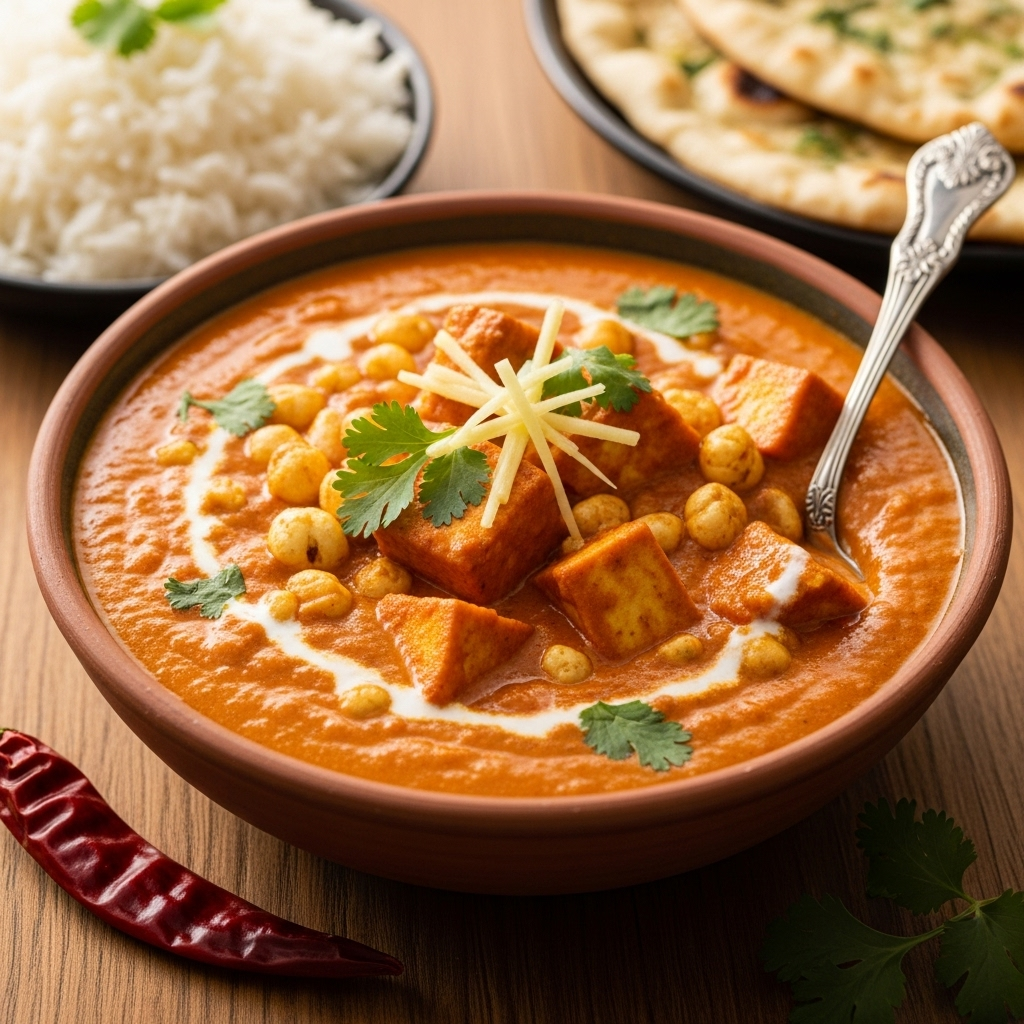
- Why: Protein-rich and comforting.
- Ingredients: Paneer cubes, roasted makhana, tomato puree (if allowed), ginger, cumin, rock salt.
- Tip: Lightly roast makhana before adding to curry for a nutty flavour.
5. Sweet Potato Curry
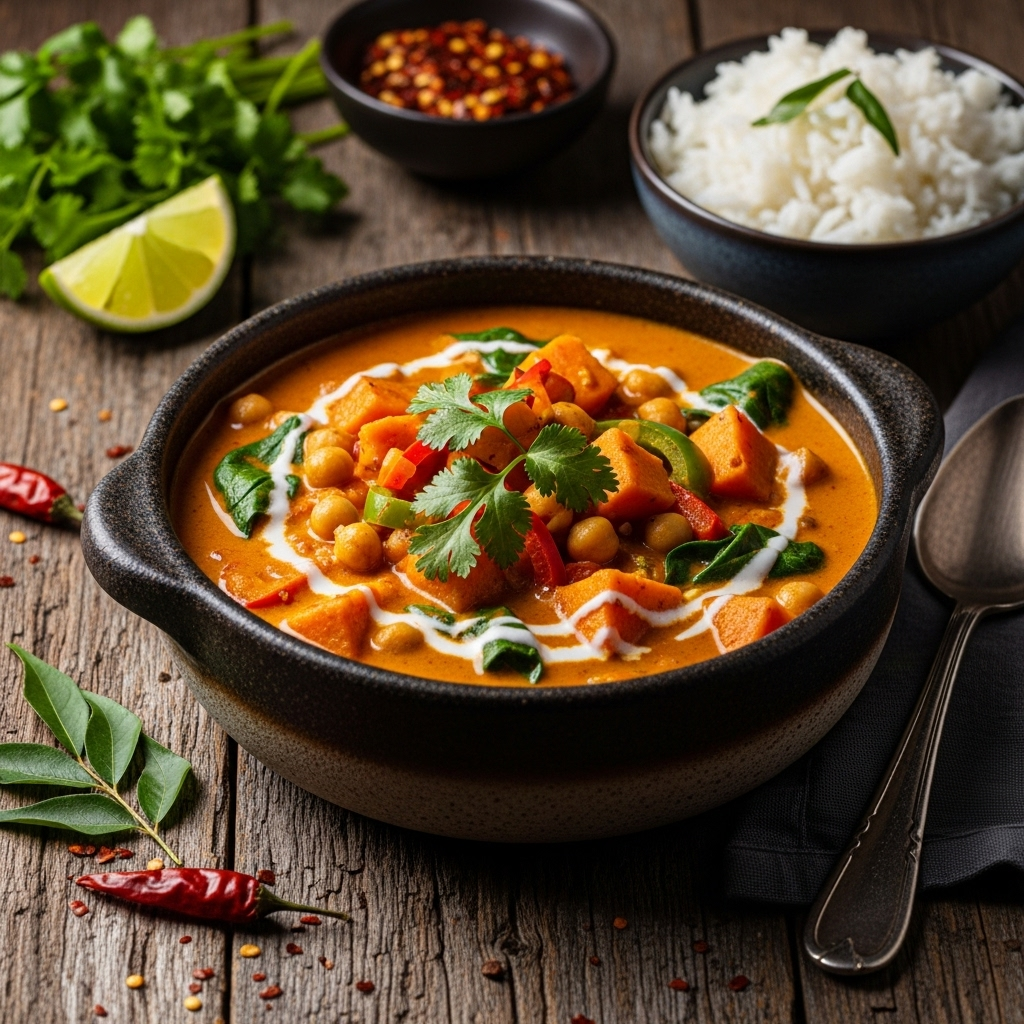
- Why: Naturally sweet, rich in fibre, and easy to digest.
- Ingredients: Boiled sweet potatoes, cumin, green chilli, coriander, rock salt.
- Tip: Mash slightly for a creamy texture.
6. Lauki (Bottle Gourd) Soup
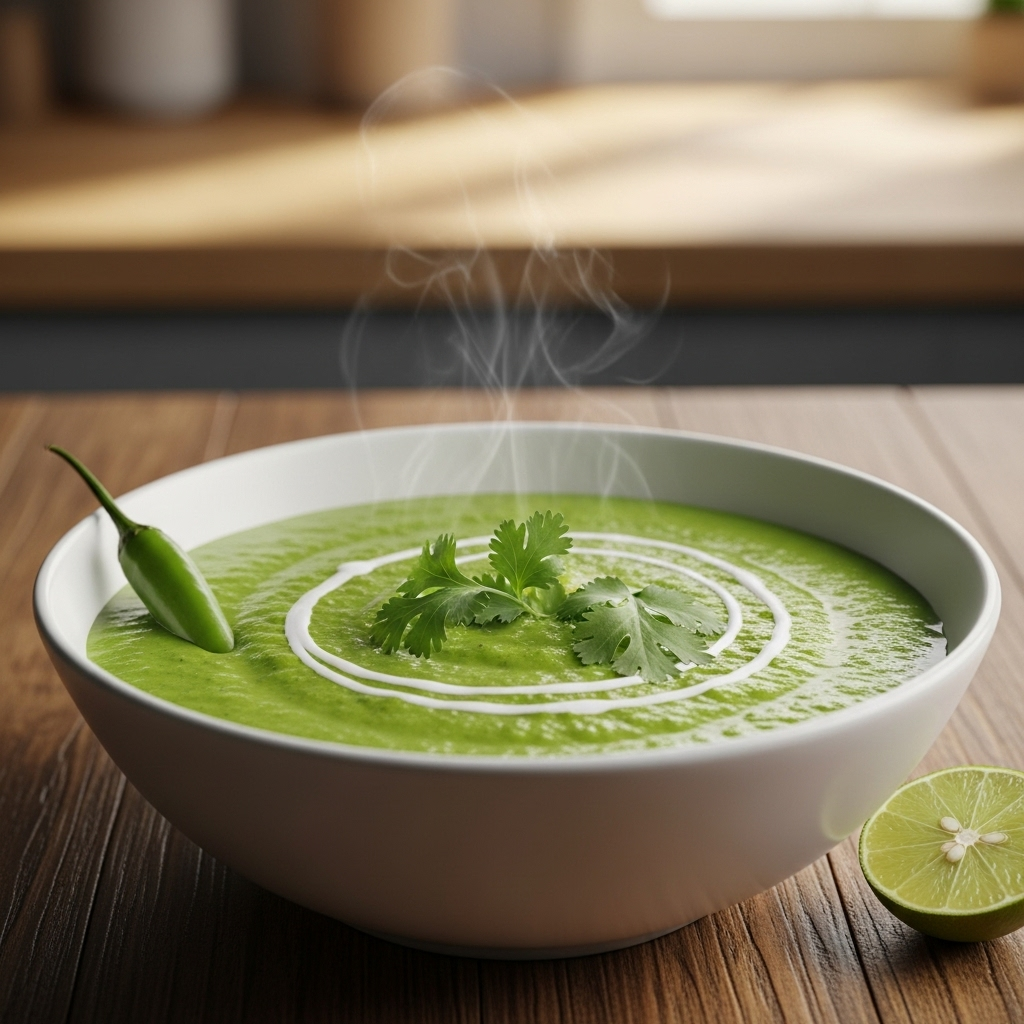
- Why: Hydrating, light, and soothing for the stomach.
- Ingredients: Bottle gourd, ginger, cumin, rock salt, ghee.
- Tip: Blend for a smooth, warm soup before bedtime.
7. Rajgira (Amaranth) Poori with Aloo Tamatar Sabzi
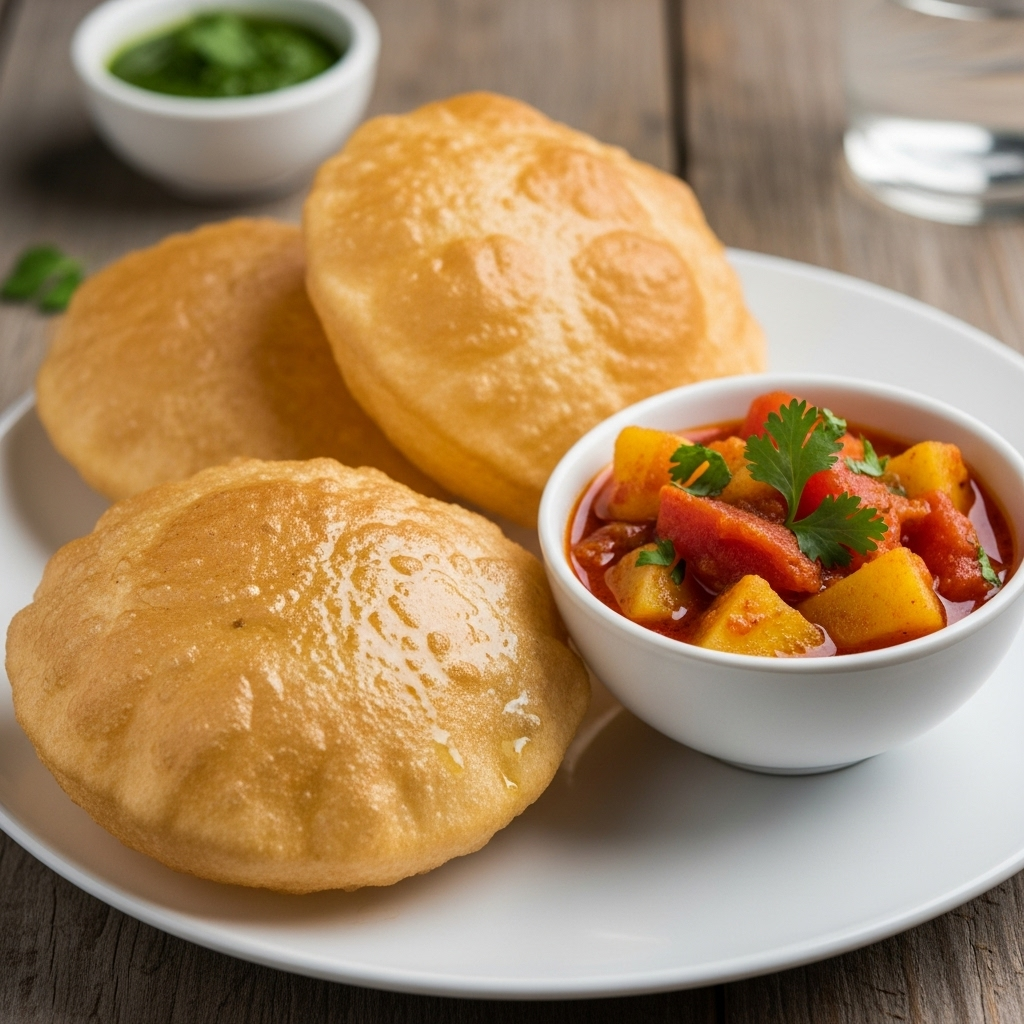
- Why: A festive yet vrat-friendly dinner option.
- Ingredients: Rajgira flour, boiled potatoes, rock salt, cumin; curry made with tomatoes and potatoes.
- Tip: Keep pooris small and shallow-fry for a lighter meal.
Accompaniments
- Raita: Mint, cucumber, or bottle gourd raita with rock salt.
- Salad: Cucumber, carrot, and pomegranate with lemon dressing.
- Drink: Warm milk with cardamom or herbal tea before bed.
Dinner Tips for Navratri
- Eat at least 2 hours before sleeping for better digestion.
- Keep portions moderate — fasting food can still be calorie-dense.
- Use ghee in small amounts for flavour and digestion.
- Avoid deep-fried snacks late at night.







